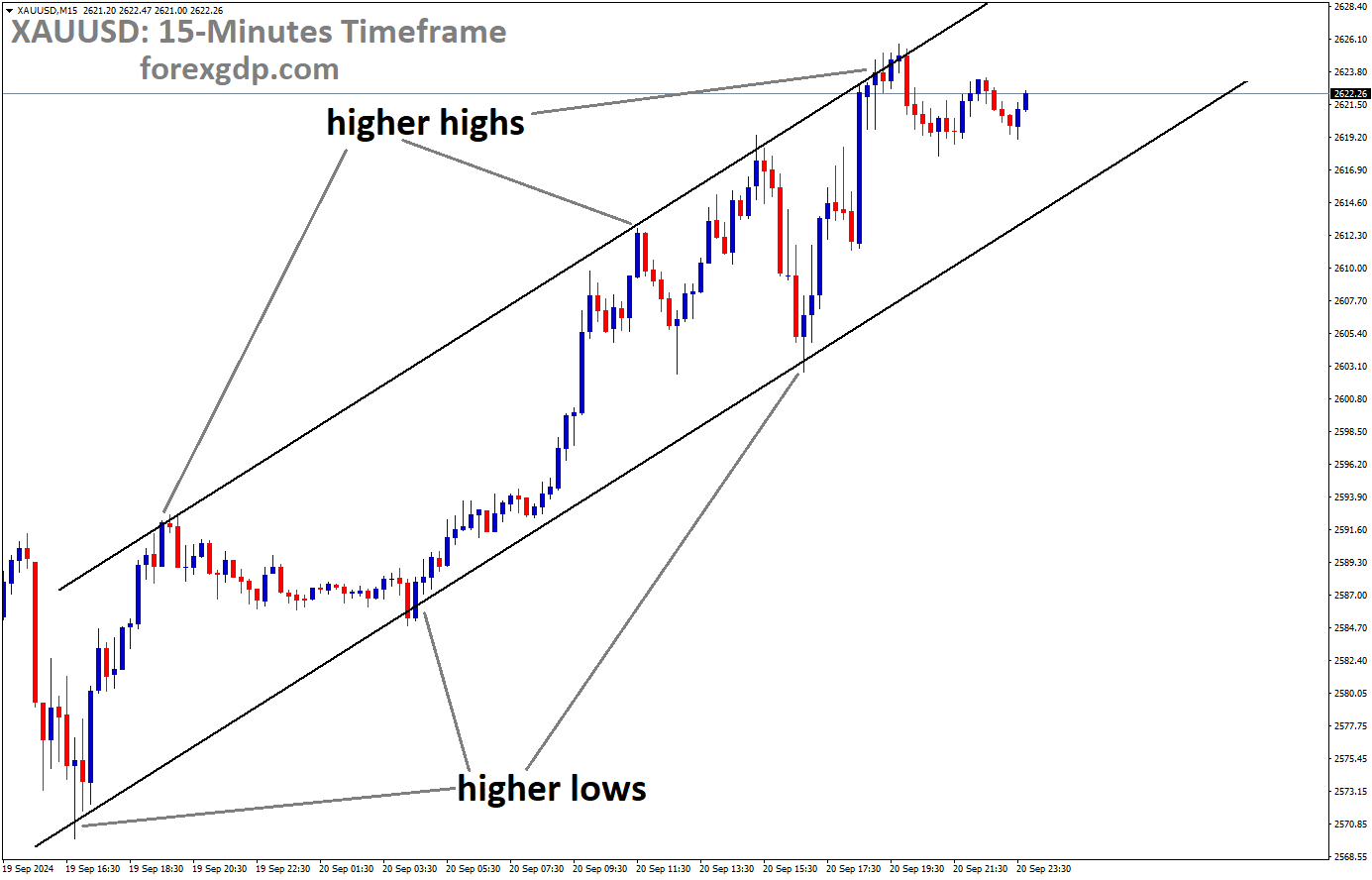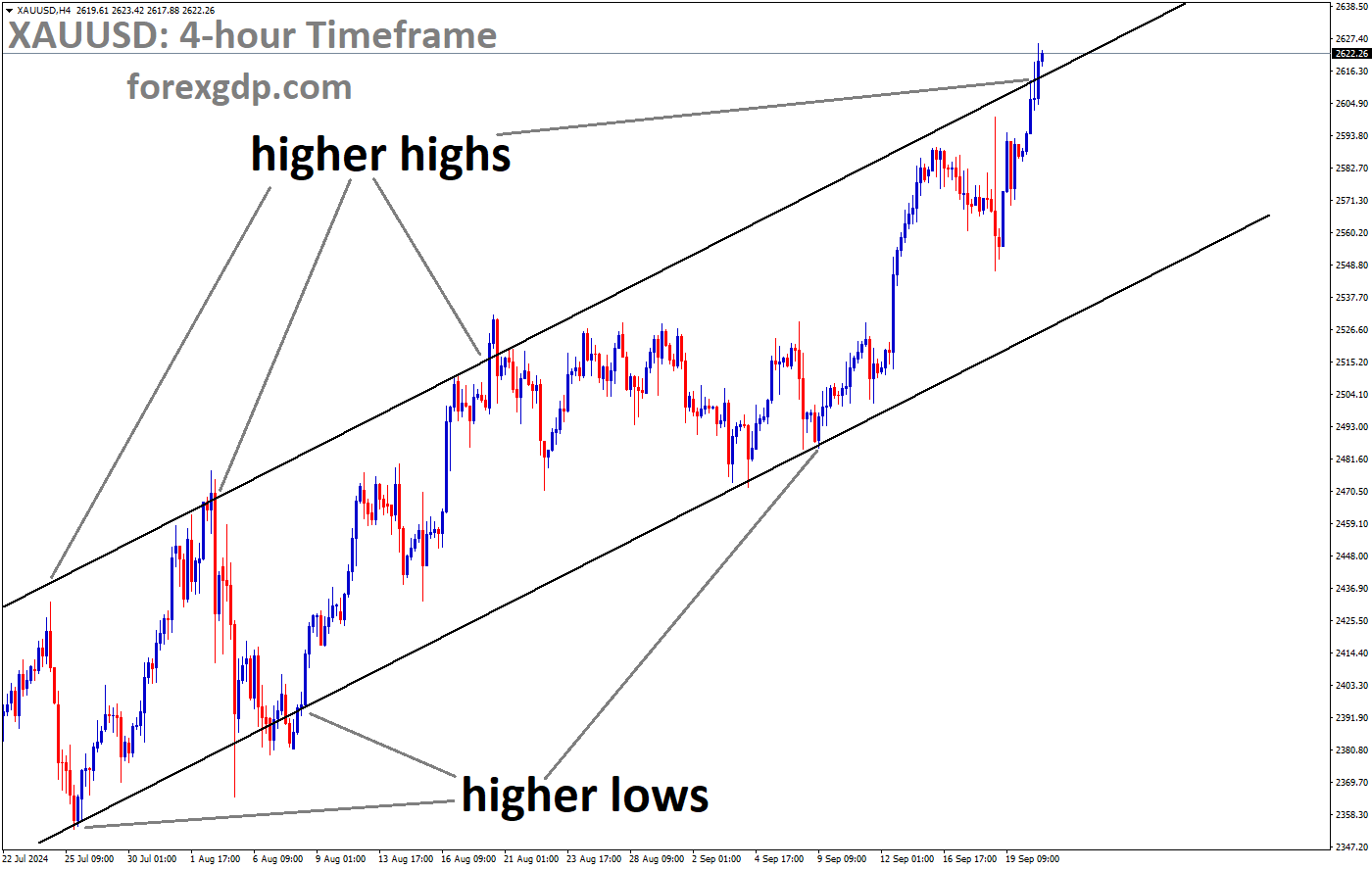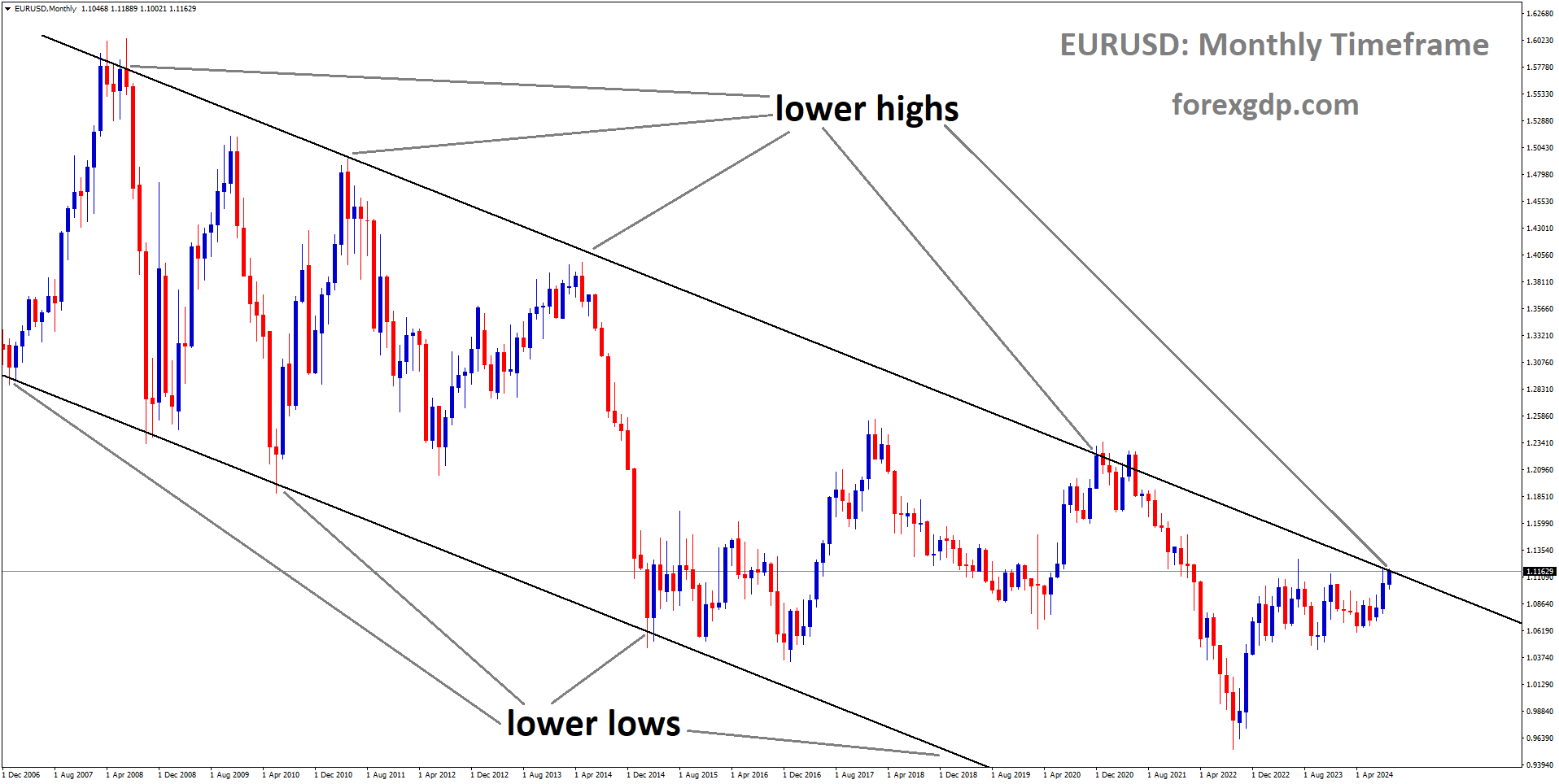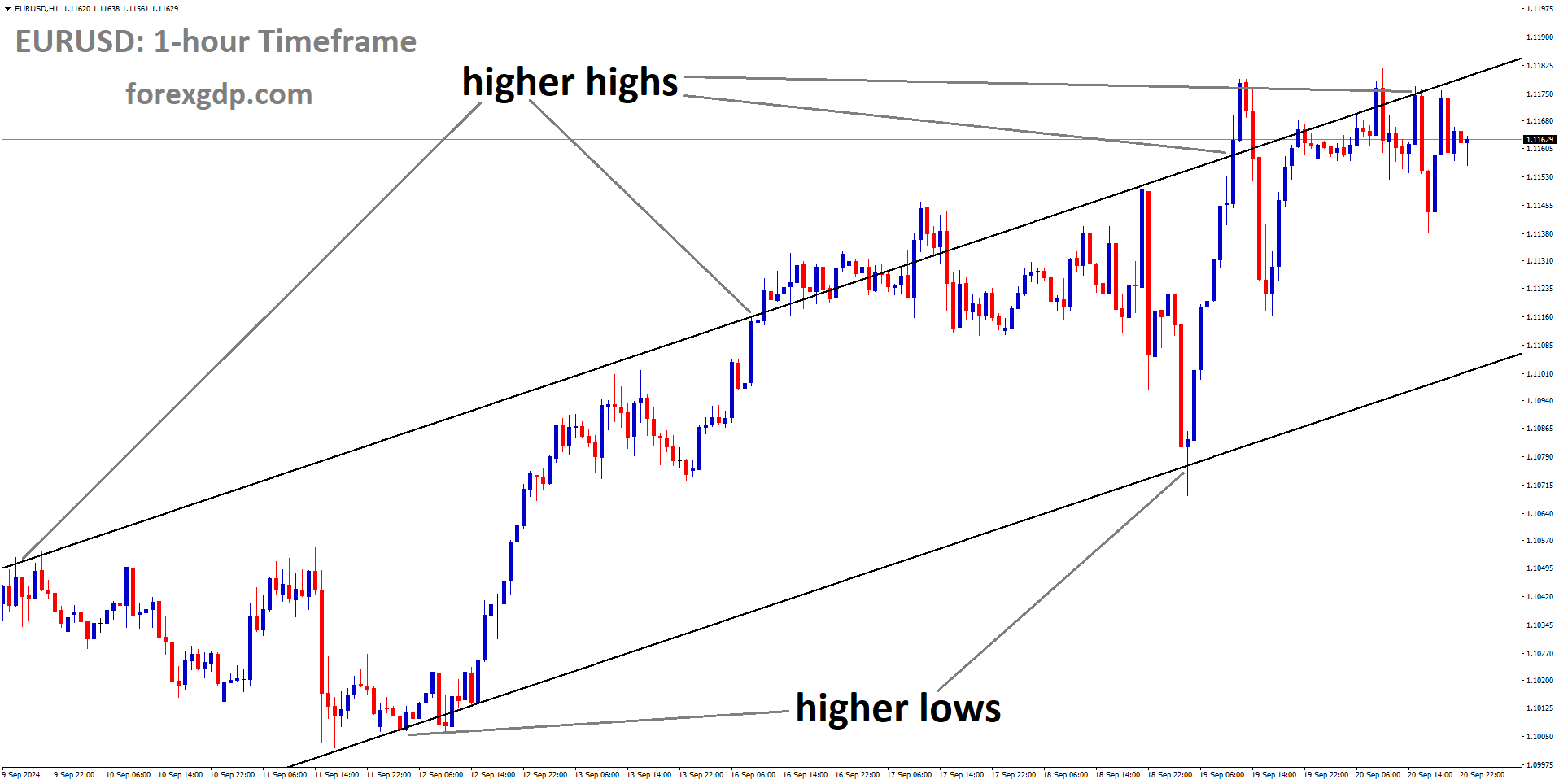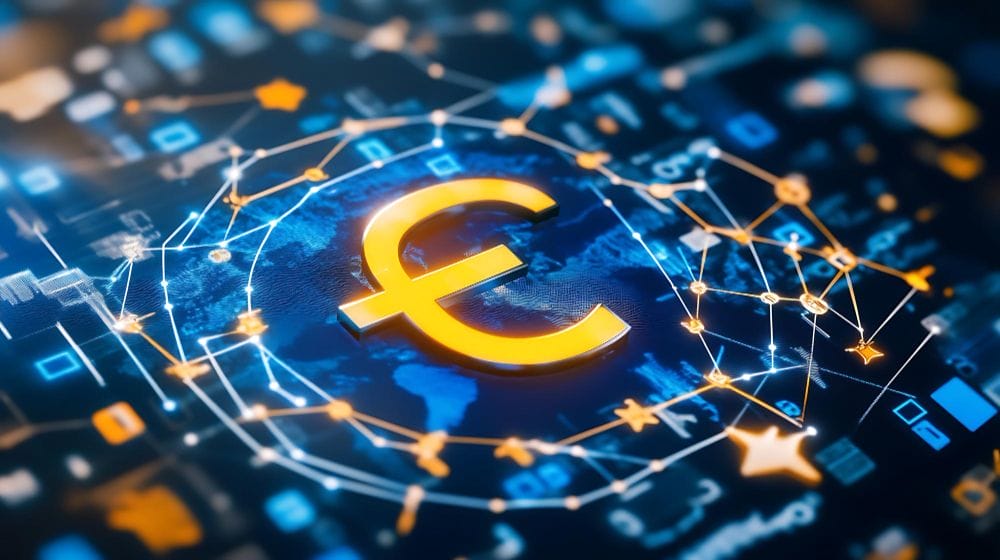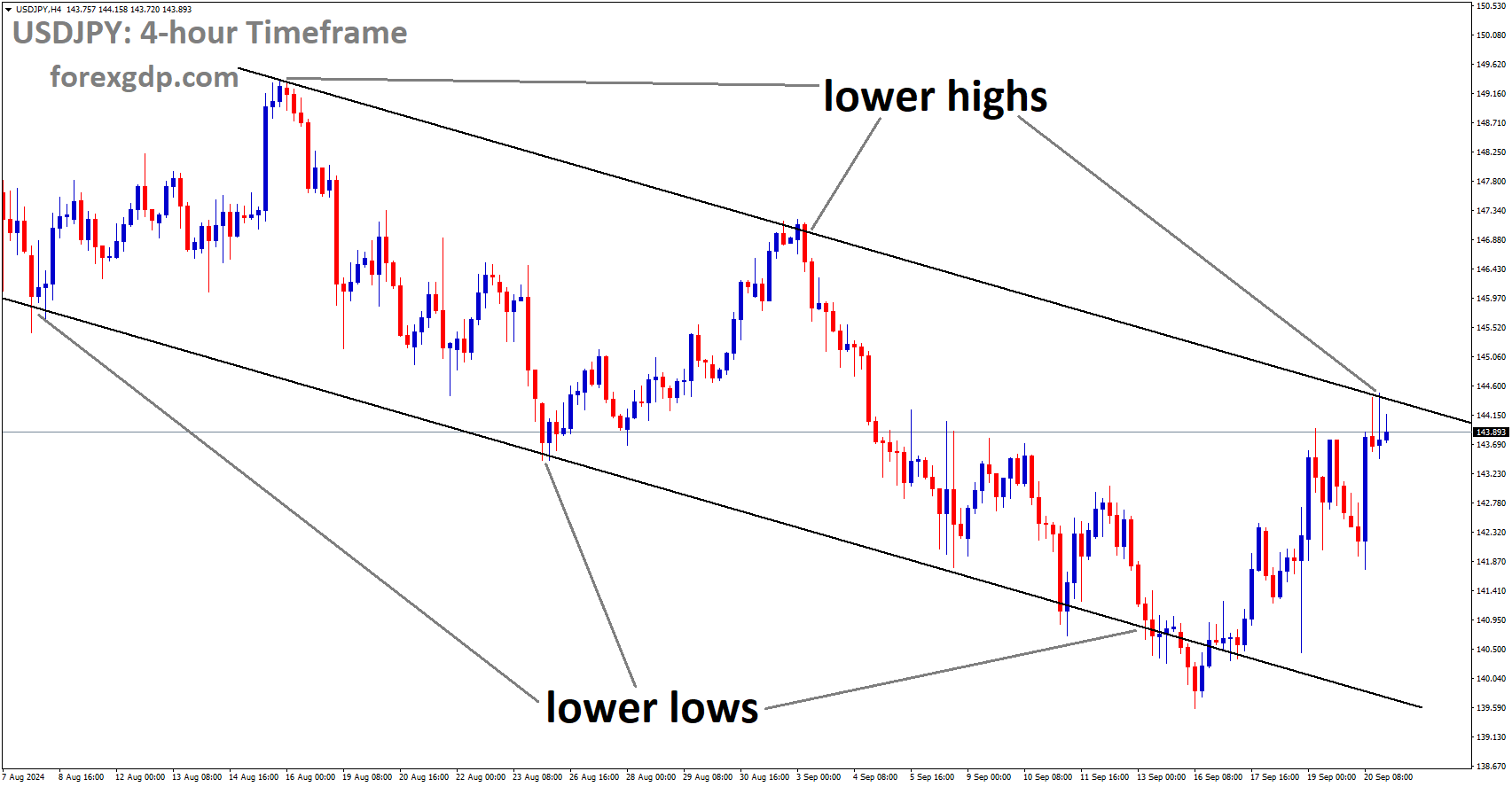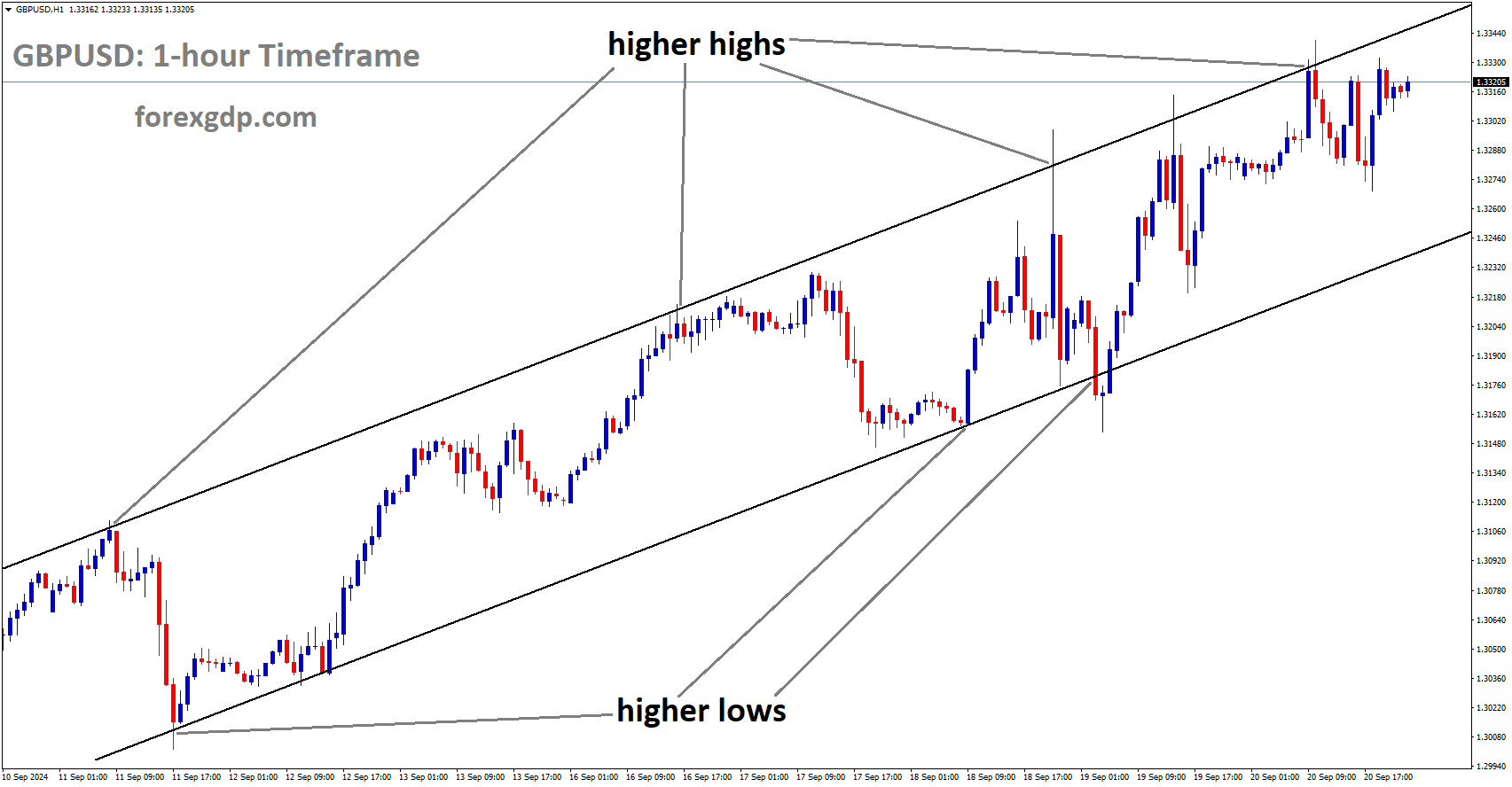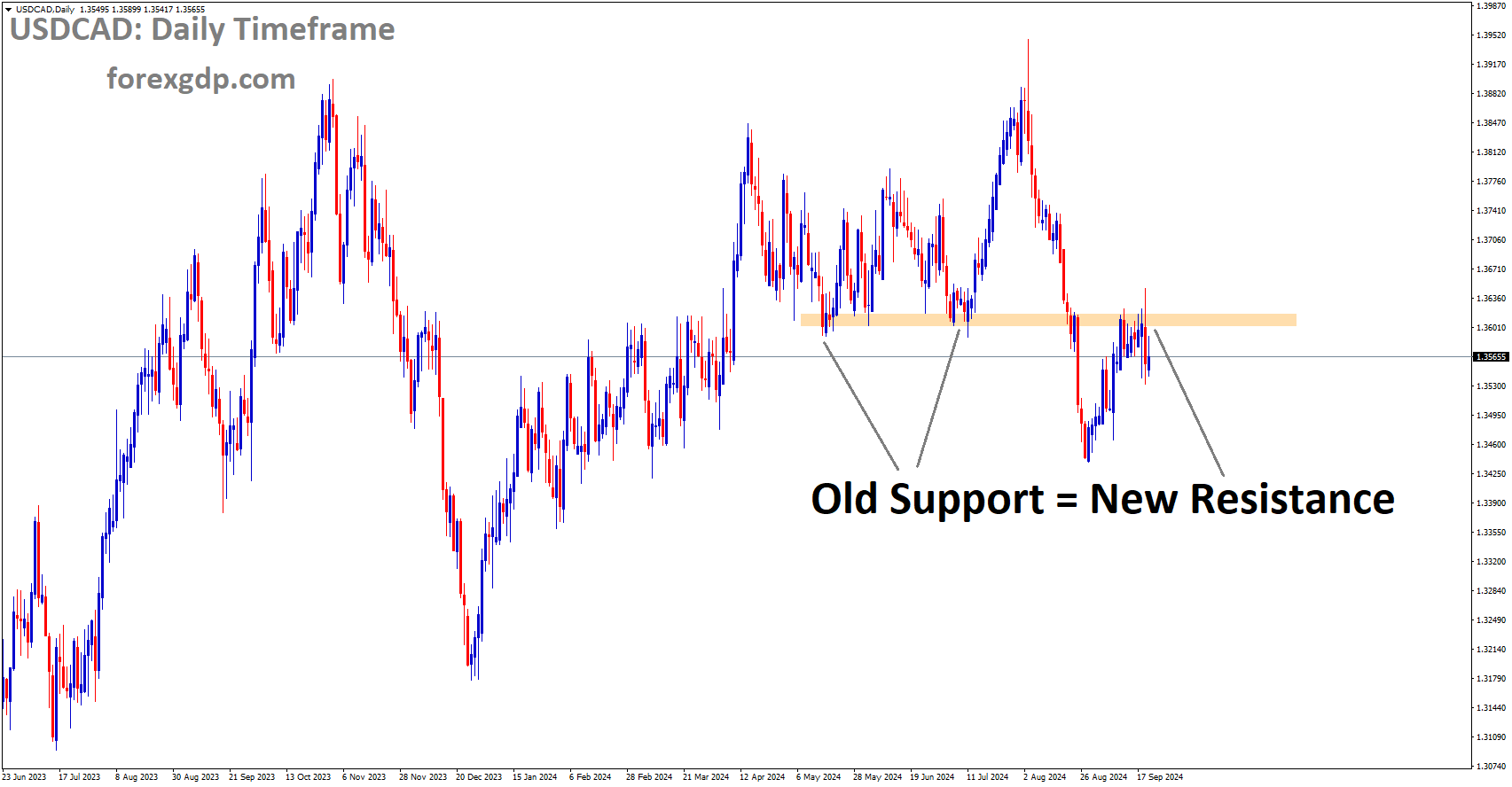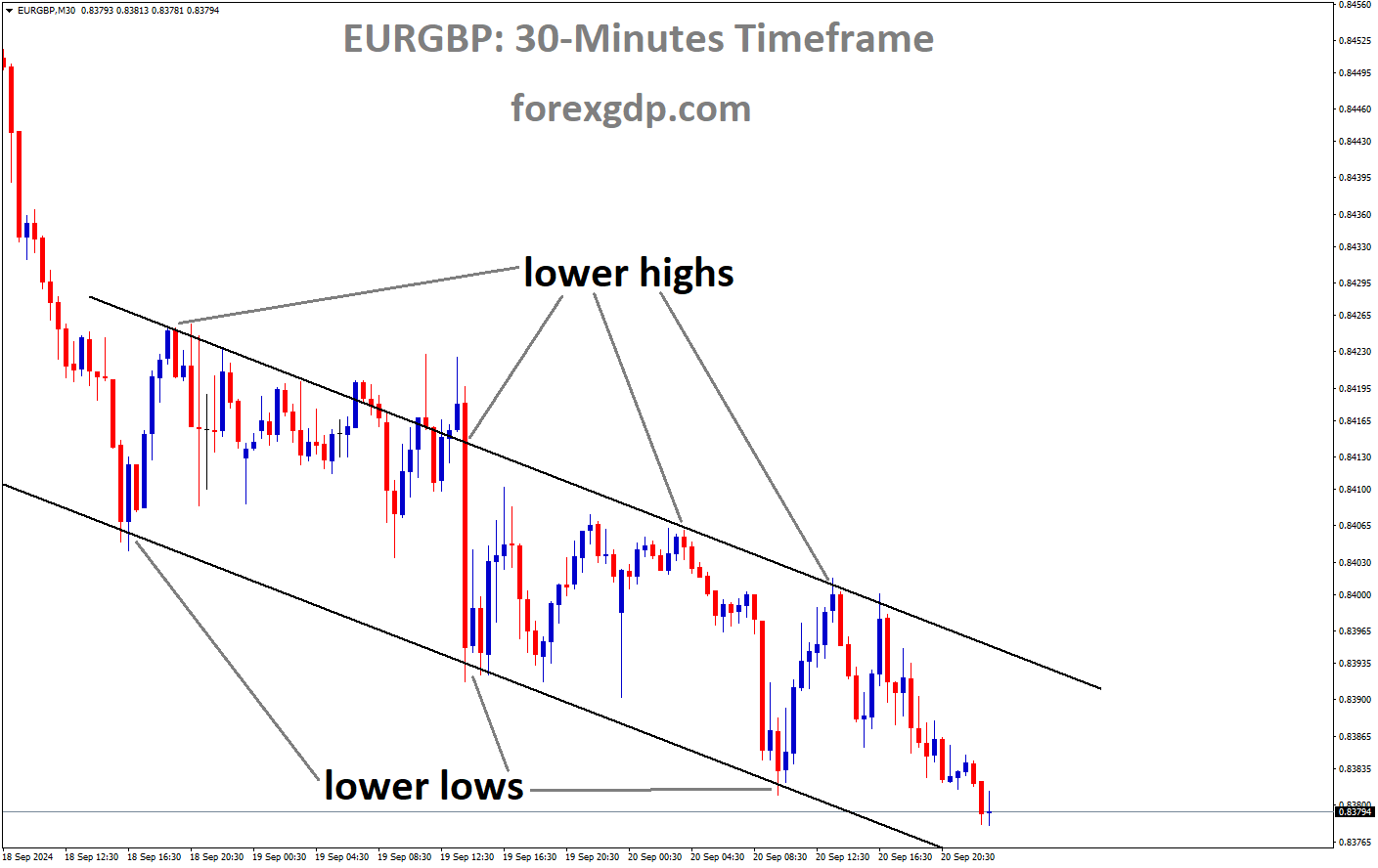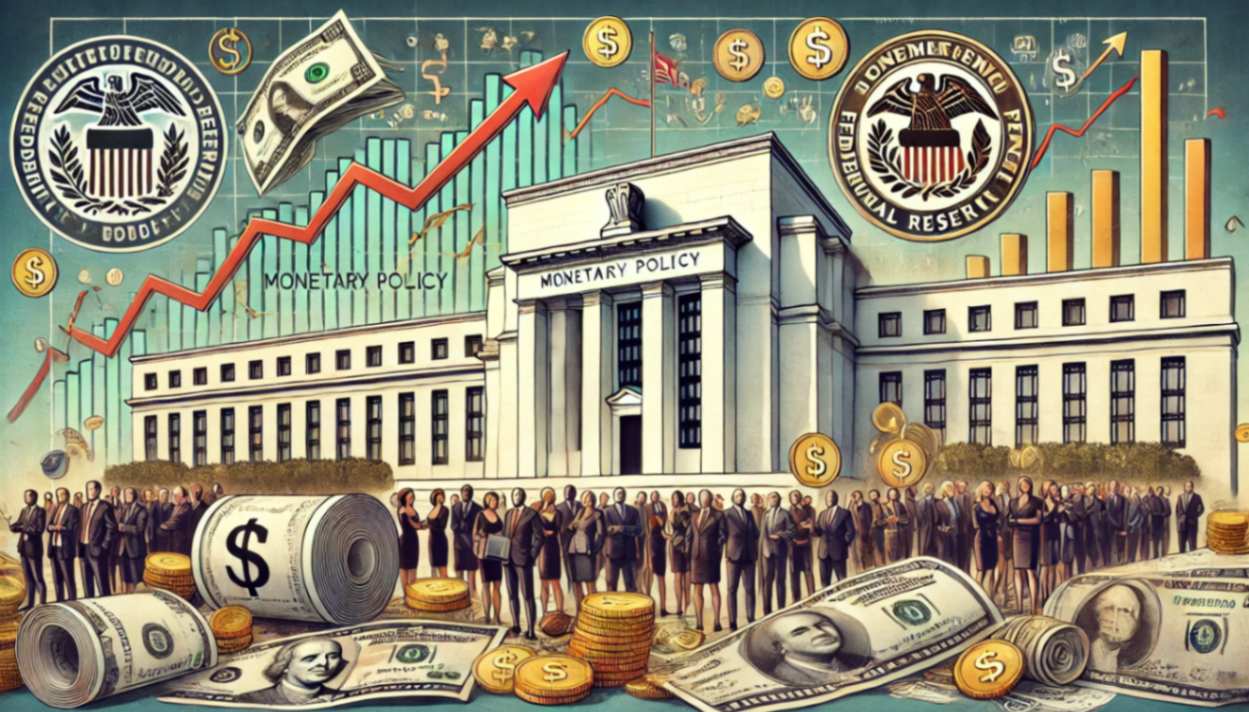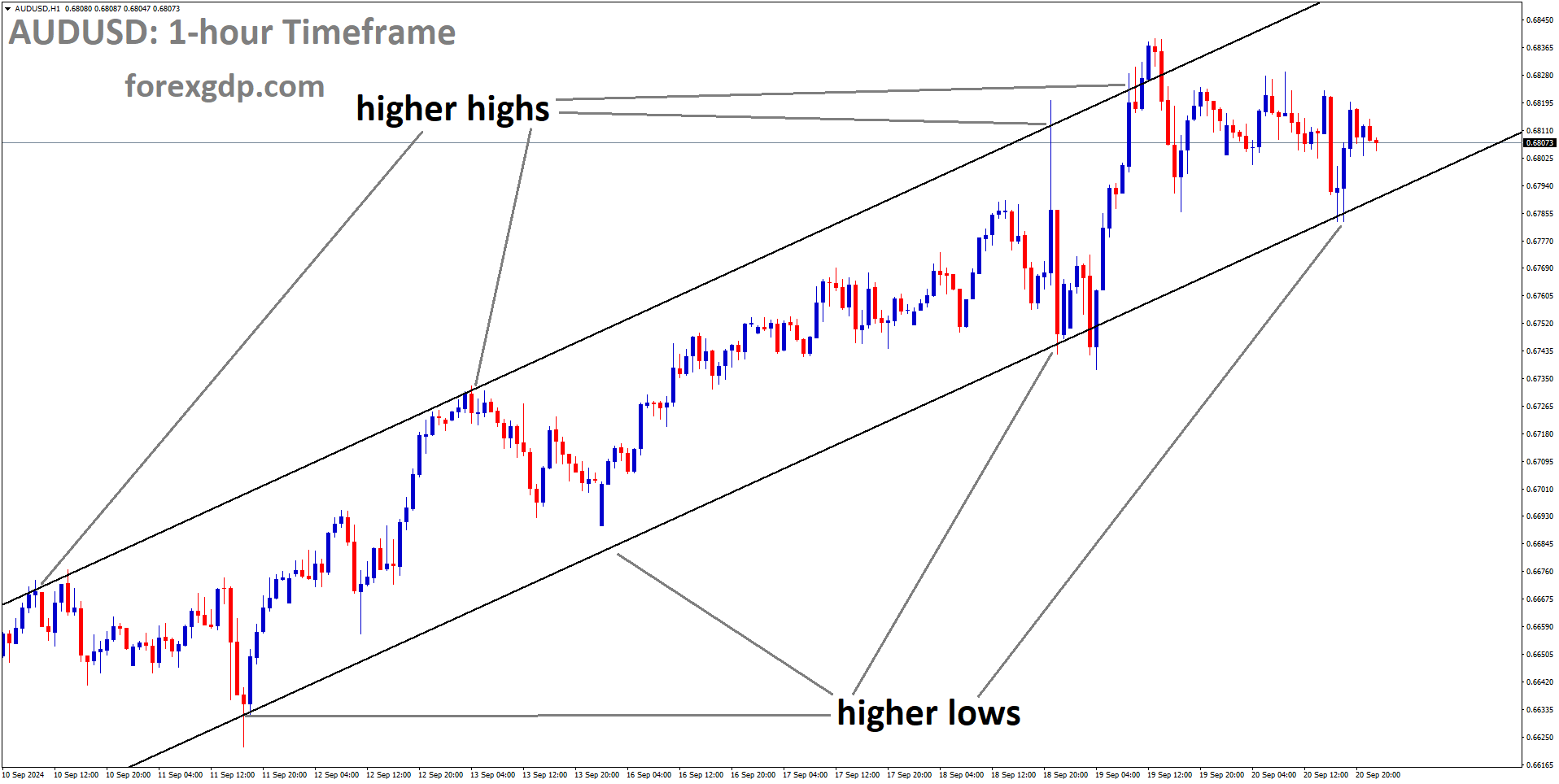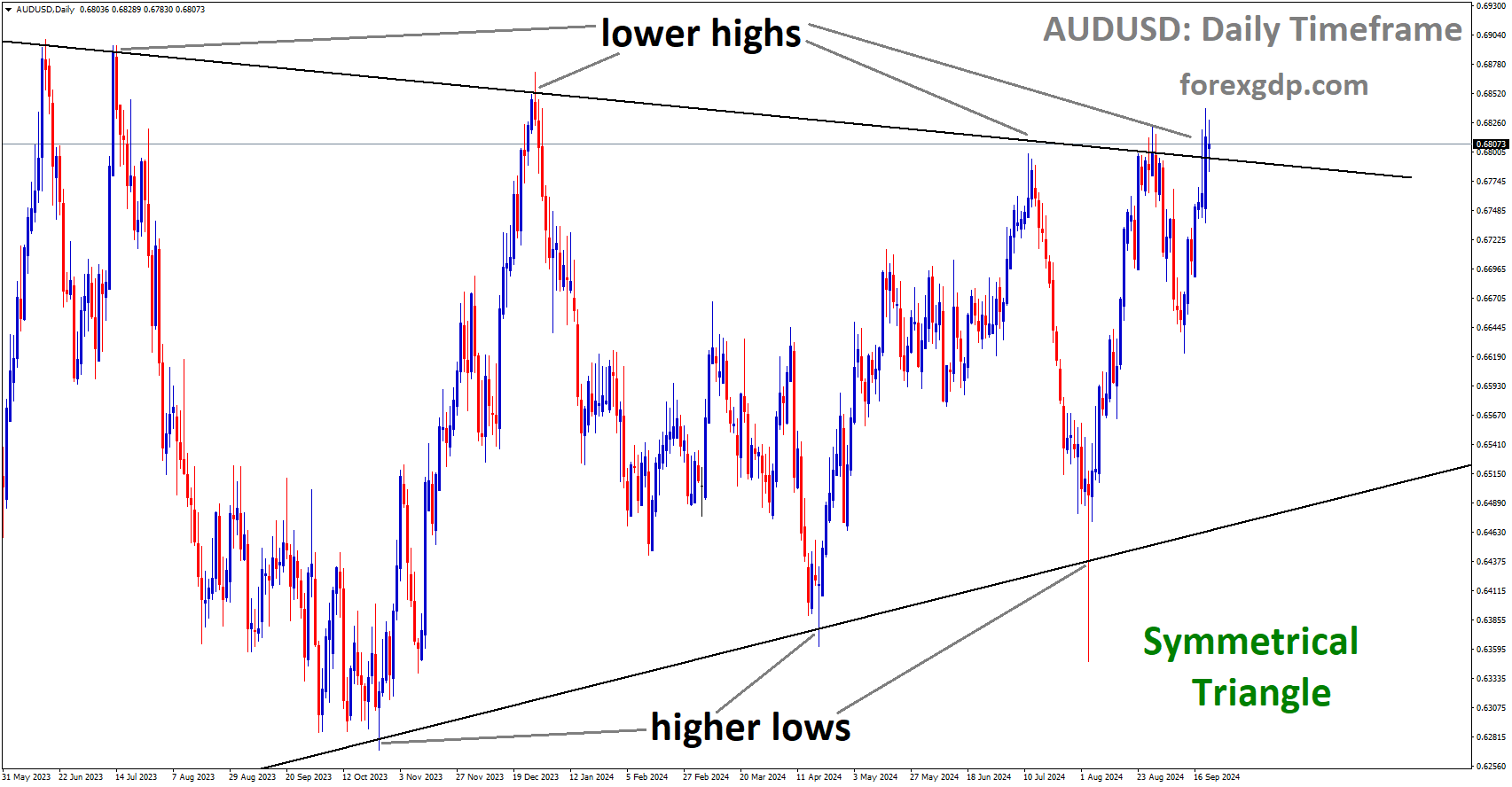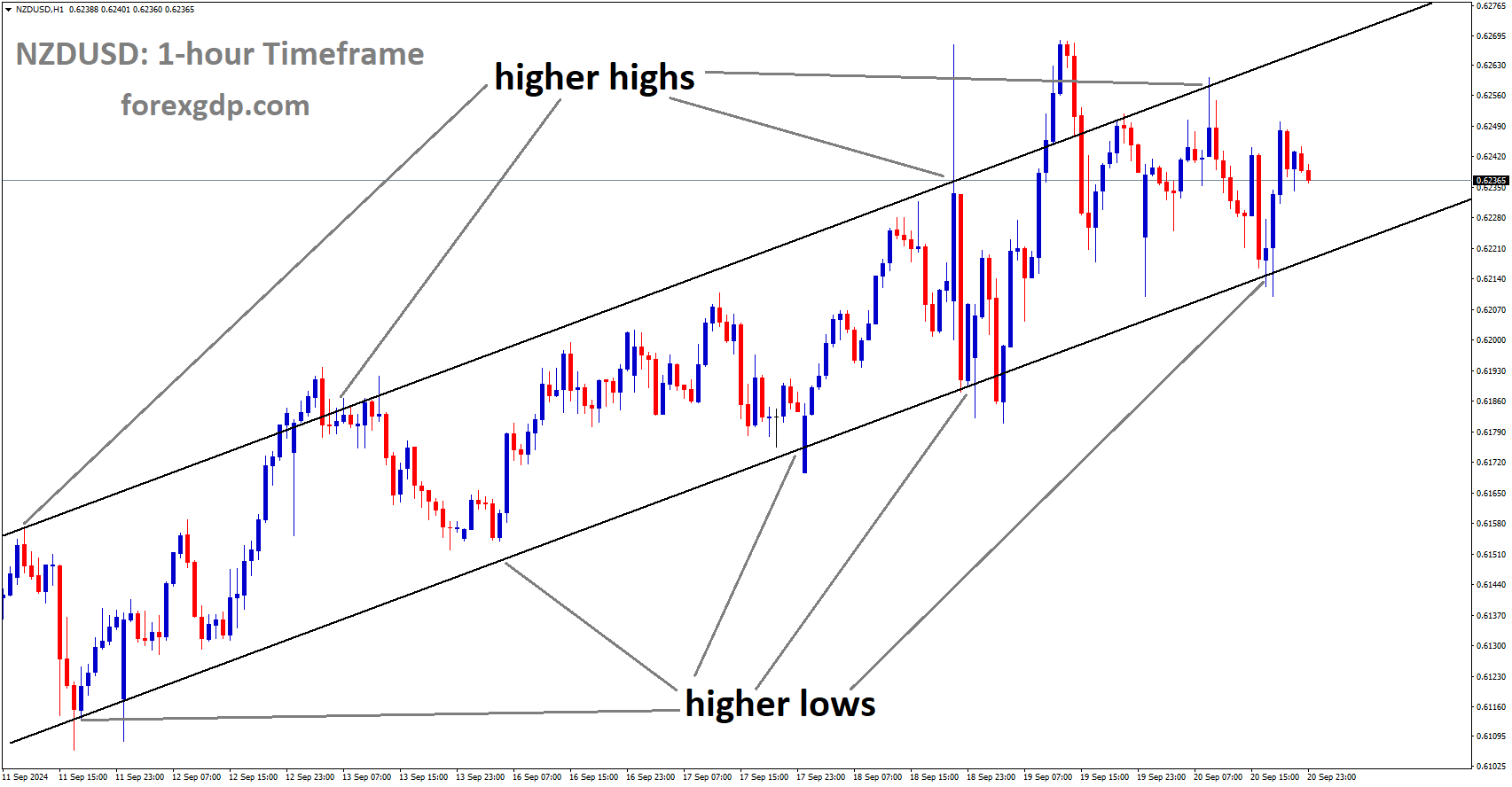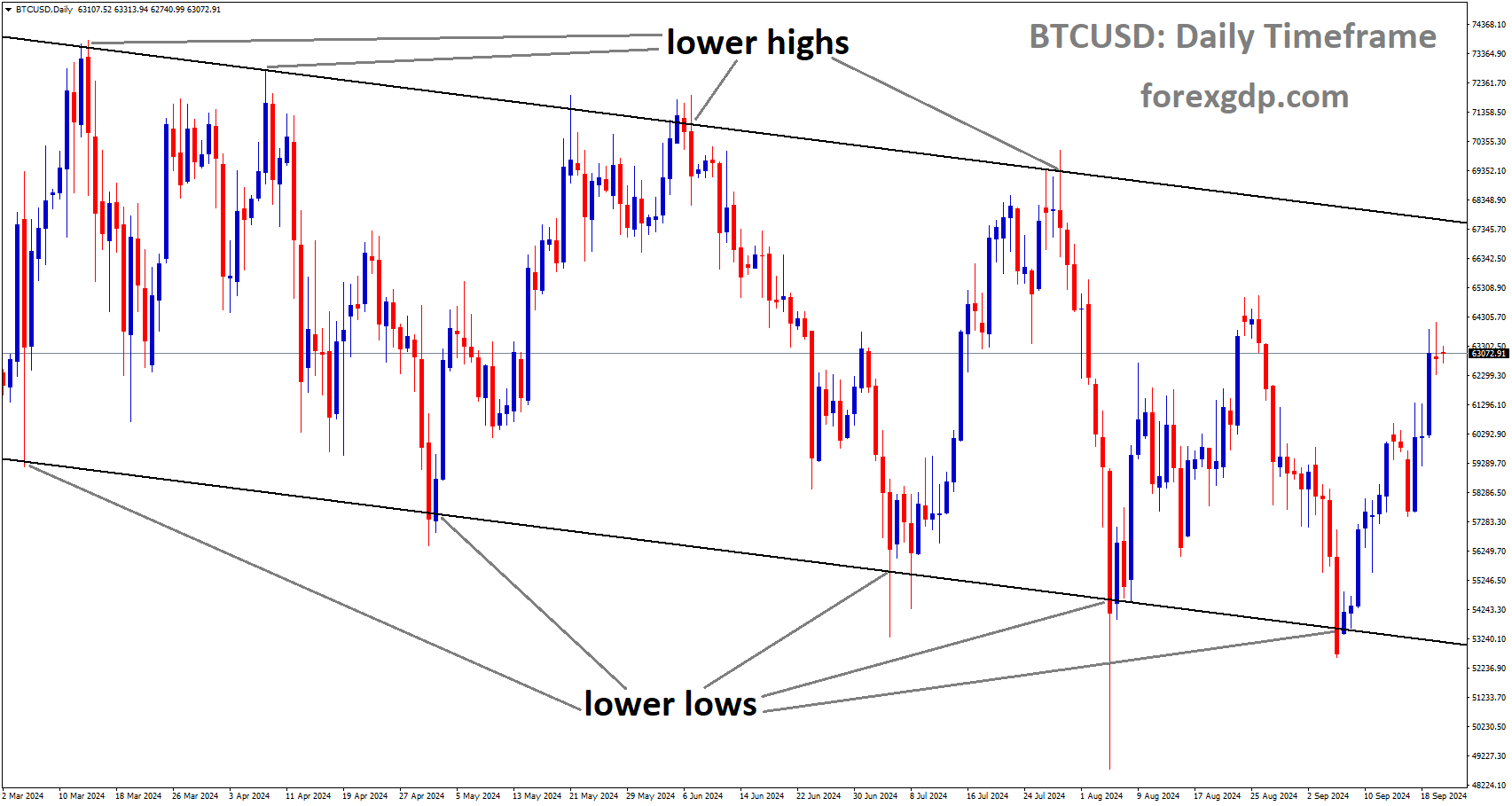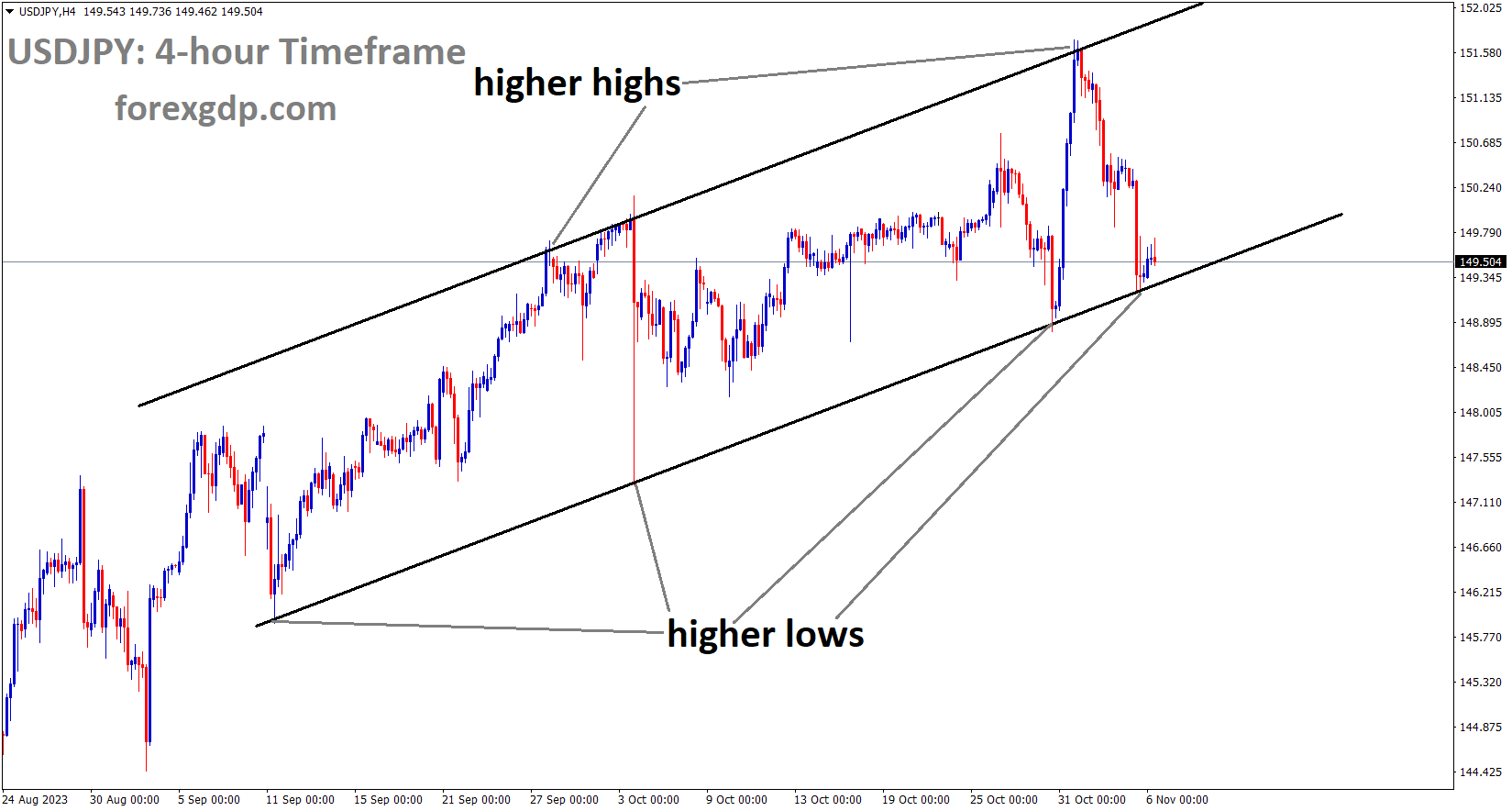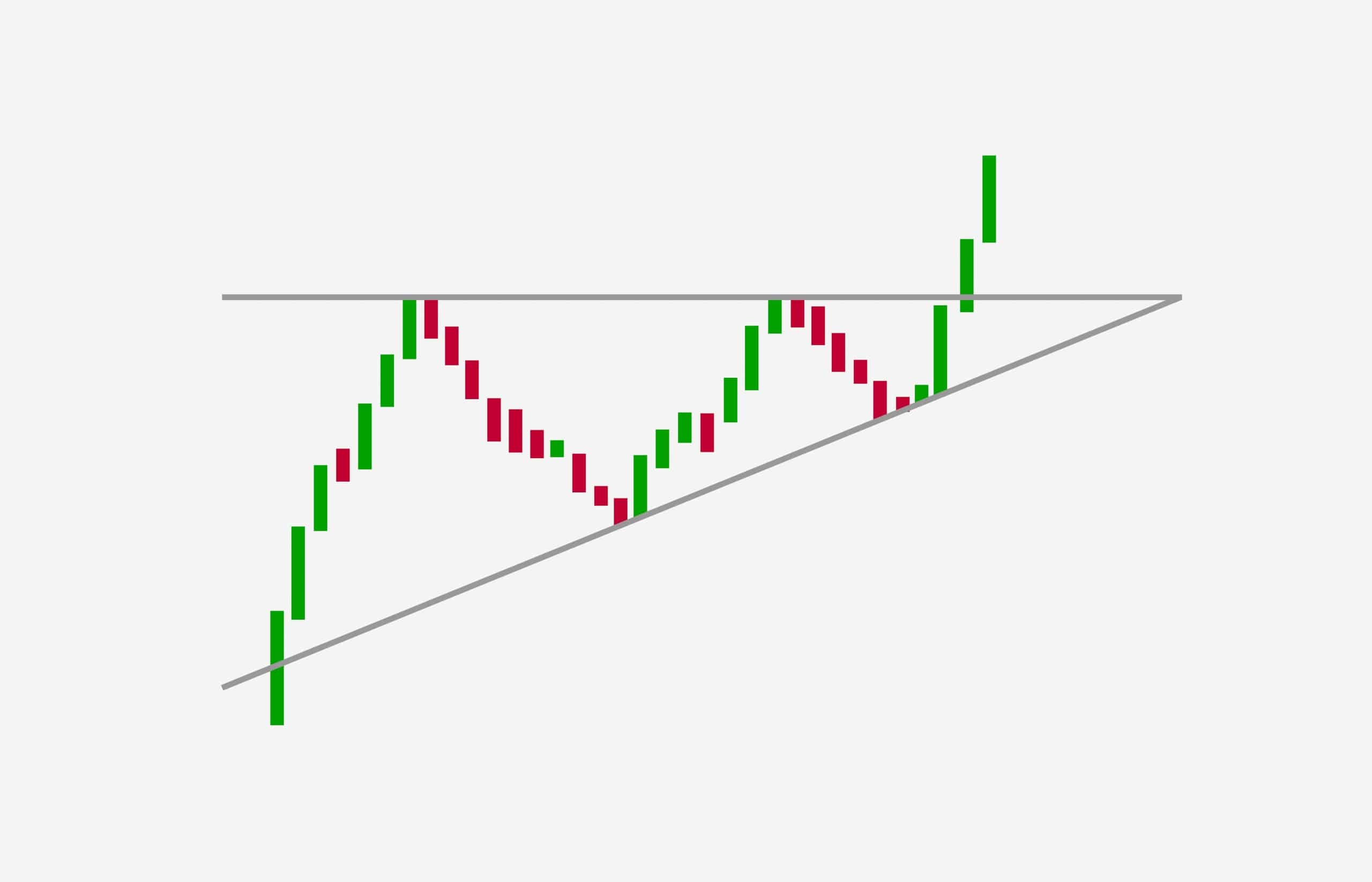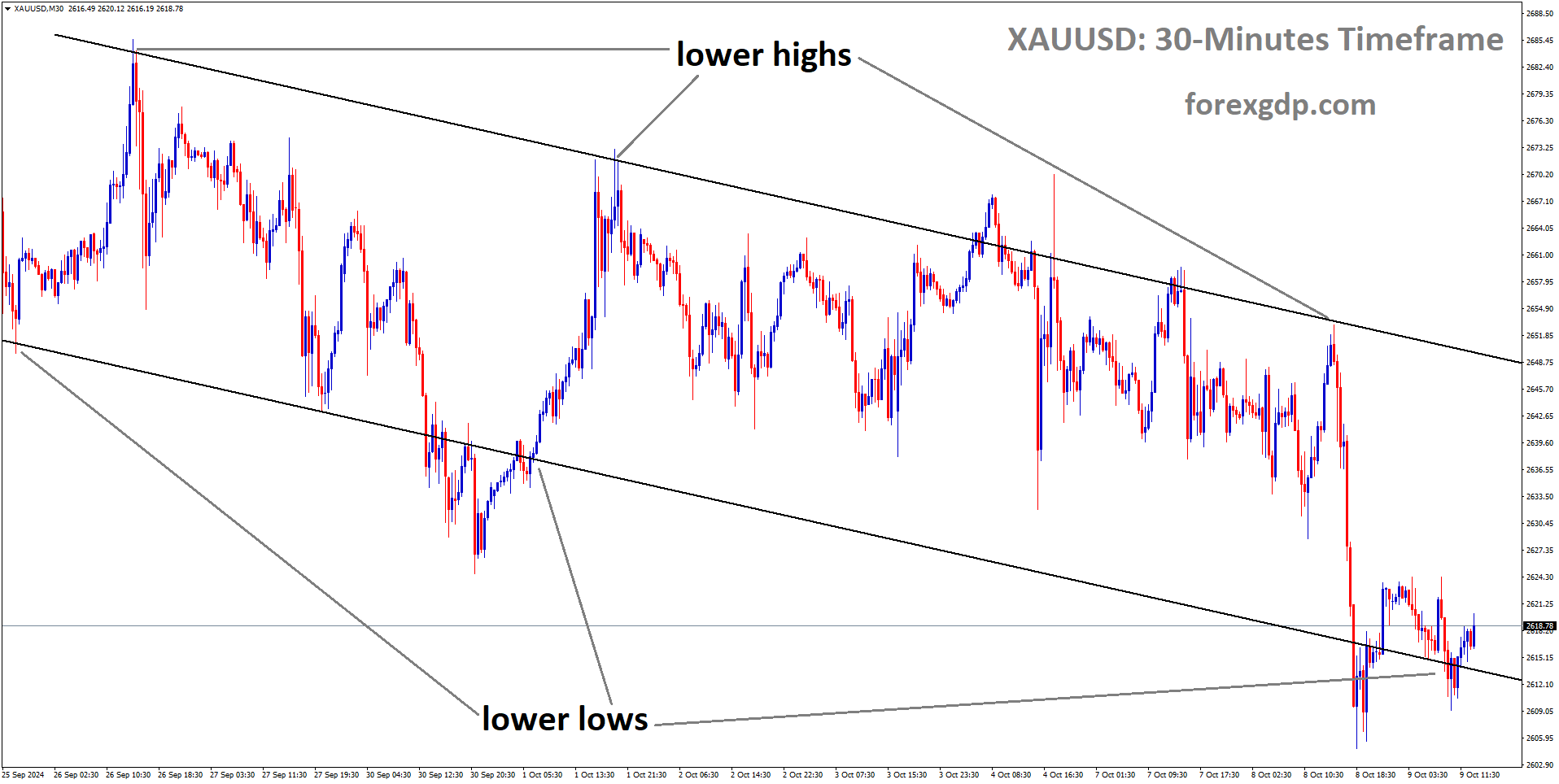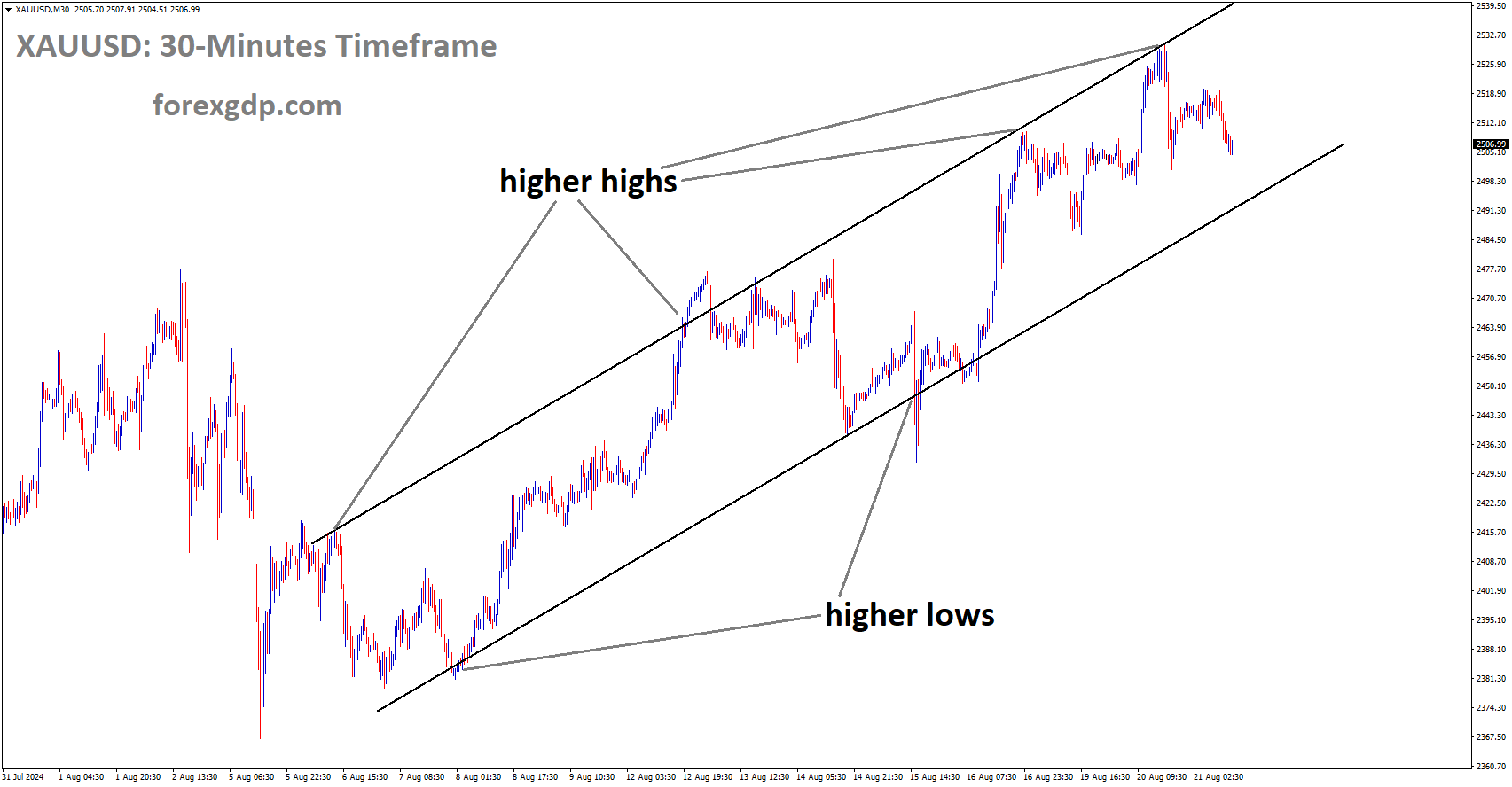Weekly Forecast Video on Forex, BTCUSD, XAUUSD
Stay ahead in the markets with our detailed analysis of gold and forex trade setups for this upcoming week, Sep 23 to Sep 27.
XAUUSD – Gold Hits Record Levels as Central Banks Prepare for Global Rate Slashes
Gold Reaches New Heights as Central Banks Ease Policies
Gold has long been a favorite asset among investors, especially during times of economic uncertainty. Recently, it has soared to new record highs as global central banks, following the Federal Reserve’s lead, continue to ease monetary policies. This decision to slash borrowing costs has played a significant role in boosting the allure of the precious metal. Let’s explore why gold is shining brighter than ever, the influence of central bank policies, and what these developments mean for investors like you.
Why Gold is Skyrocketing: A Closer Look
Gold prices are soaring, and many are asking, “Why now?” The answer lies in a combination of factors that have converged to push this precious metal to new heights.
Global Central Banks and Interest Rate Cuts
The Federal Reserve recently cut interest rates by 0.50%, and this decision has triggered a ripple effect around the globe. Several other central banks are now following suit, reducing their own rates in response to economic pressures. Lower interest rates are a significant factor behind gold’s surge because they decrease the opportunity cost of holding non-interest-bearing assets like gold. In simple terms, when interest rates are low, investors find gold more attractive because they are not missing out on returns they might otherwise get from interest-paying investments.
For instance, the South African Reserve Bank (SARB) cut its key interest rate by 25 basis points (bps), marking its first rate reduction since the Covid pandemic began. Similarly, the Philippines Central Bank slashed its interest rates by a substantial 250 bps. Although these actions were influenced by the Federal Reserve’s decisions, other factors like global inflation and economic slowdown are also at play.
Meanwhile, the People’s Bank of China (PboC) opted to keep its interest rates unchanged in September, but the existing rates are already at historically low levels after a surprise cut in July. These decisions, combined with speculation of further rate cuts, are fueling the ongoing rally in gold prices.
Geopolitical Tensions and Gold’s Safe-Haven Status
Beyond the economic landscape, geopolitical uncertainties have also played a key role in supporting gold’s recent surge. Whenever political or military conflicts arise, gold tends to benefit from its safe-haven status. Investors flock to gold as a way to protect their wealth during periods of uncertainty.
XAUUSD is moving in an Ascending channel, and the market has fallen from the higher high area of the channel
One such example is the increased tension in the Middle East, where Israel’s military operations have intensified. This has sparked concerns about potential escalations, making gold an appealing asset for those looking to safeguard against risk. In times of war or instability, gold tends to hold or increase its value, making it a reliable store of wealth.
Central Bank Policies and Their Impact on Gold
Monetary policy plays a significant role in shaping the financial landscape, and recent decisions by central banks worldwide have given gold a major boost. Let’s dive deeper into how these policy changes are affecting the precious metal.
The Fed’s Influence on Global Markets
The Federal Reserve’s decision to cut interest rates was primarily driven by concerns over the U.S. economy’s long-term growth prospects. By reducing borrowing costs, the Fed aims to stimulate economic activity, encouraging businesses and consumers to spend and invest. However, this also affects other asset classes, including gold.
Lower interest rates reduce the yield on traditional investments like bonds, making non-interest-bearing assets such as gold more attractive. As a result, investors have been pouring their money into gold, driving up prices.
But the Fed’s decision has had far-reaching implications beyond the U.S. In response, many central banks around the world have followed suit, cutting their own interest rates to keep their economies competitive and stave off potential recessions.
Global Central Banks Join the Easing Trend
Following the Fed’s rate cut, a number of central banks took similar steps:
- The Reserve Bank of India (RBI) is widely expected to cut its rates soon, as it looks to support its economy during challenging times.
- The Bank of Japan (BoJ), while choosing to keep its rates unchanged for now, continues to face pressure to stimulate growth, especially in light of other central banks’ actions.
All these moves indicate a broad trend of monetary easing across the globe, which is positive for gold. When interest rates are slashed, currencies often weaken, and investors turn to gold as a stable alternative.
XAUUSD is moving in an Ascending channel, and the market has reached the higher high area of the channel
What Does This Mean for You?
So, what does all this mean for you as an investor? If you’re holding gold, it’s likely been a rewarding time. With central banks showing no signs of reversing their easing policies, gold’s upward momentum might continue for the foreseeable future.
Here’s why gold could continue to perform well in the current environment:
- Lower Opportunity Costs: As we’ve discussed, when interest rates fall, the cost of holding gold decreases. With lower yields on traditional assets, gold becomes a more appealing option for both large institutional investors and individuals.
- Inflation Hedge: Gold has traditionally been seen as a hedge against inflation. As central banks ease monetary policy and pump more money into the economy, inflation could rise, making gold even more valuable as a protective asset.
- Safe-Haven Appeal: Geopolitical tensions, economic uncertainty, and potential financial crises all make gold an attractive safe haven for investors. Whenever the future looks uncertain, gold tends to shine.
Should You Consider Investing in Gold?
If you’ve been on the fence about gold, now might be the time to take a closer look. Gold’s recent price surge has been driven by strong fundamentals, and many experts believe that it still has room to run. However, it’s essential to remember that gold, like any investment, carries risks. Its value can fluctuate based on a range of factors, including economic data, interest rates, and geopolitical events.
If you’re considering investing in gold, you have several options:
- Physical Gold: You can purchase gold in its physical form, such as bars or coins, which you can store for safekeeping.
- Gold ETFs: Exchange-traded funds (ETFs) offer a convenient way to gain exposure to gold without having to own the physical asset.
- Gold Mining Stocks: Another way to invest in gold is by purchasing shares in gold mining companies. These stocks tend to move in tandem with gold prices but may offer additional growth opportunities.
Final Thoughts: Gold’s Role in a Changing Economic Landscape
Gold has always been a trusted asset in times of uncertainty, and its recent surge to record highs highlights its ongoing relevance. With global central banks continuing to ease monetary policies and geopolitical risks on the rise, gold’s appeal as a safe-haven investment has only strengthened.
If you’re looking for a way to protect your wealth in these uncertain times, gold might be a smart addition to your portfolio. However, it’s essential to stay informed and understand the factors driving the market to make well-informed decisions.
As always, keep an eye on economic trends, central bank policies, and geopolitical developments to stay ahead of the curve. Whether you’re an experienced investor or just getting started, gold offers a unique opportunity to diversify and safeguard your investments in today’s complex financial world.
EURUSD – Euro Struggles Below 1.1150 as Investors Gear Up for Lagarde’s ECB Remarks
EUR/USD Dips Below 1.1150 as US Dollar Strengthens: What’s Next?
The EUR/USD currency pair, one of the most traded in the world, has recently experienced a drop below the 1.1150 level. This has caught the attention of many investors and traders, especially as the US Dollar (USD) makes a comeback. As market players eagerly await upcoming events, especially related to interest rates, the broader market mood remains cautious. In this article, we’ll dive deeper into the reasons behind the EUR/USD movements, what key figures are saying, and what you should keep an eye on.
EURUSD is moving in a descending channel, and the market has reached the lower high area of the channel
EUR/USD Dips Amid US Dollar Strengthening
The recent dip in EUR/USD is mainly attributed to the renewed strength of the US Dollar. After a period of weakening, the US Dollar Index (DXY), which measures the strength of the USD against a basket of major currencies, has bounced back close to the 101.00 mark. This reversal has come as a surprise to many, given the uncertainty surrounding the broader economic outlook in the United States.
The Federal Reserve’s recent decision to cut interest rates by 50 basis points (bps) raised eyebrows. While it signals the Fed’s intention to support the labor market, it’s also a sign that inflation is on its way down to the central bank’s target of 2%. However, the situation is still fluid, and market expectations about future rate cuts remain uncertain.
Why Did the US Dollar Strengthen?
There are several reasons behind the US Dollar’s sudden bounce back. One of the key factors is the Federal Reserve’s continued interest rate adjustments. The market is buzzing with predictions about where interest rates might go next, and some believe we may see even further cuts in the near future. The Fed’s dot plot suggests the federal fund rate could hit 4.4% by the end of the year. However, many traders are expecting even more aggressive cuts, with the possibility of rates dropping to 4.00%-4.25%.
Investors are closely monitoring speeches from prominent Fed officials, such as Patrick Harker, to get a clearer sense of future monetary policy. In addition to these Fed communications, other data points, such as consumer confidence reports, are helping to shape market sentiment. For instance, the Eurozone’s consumer confidence reading is also playing a role in influencing the EUR/USD pair.
What Is Happening in the Eurozone?
On the other side of the Atlantic, the Euro is also facing its share of challenges. While the Euro performed relatively well against other major currencies earlier this year, growing concerns about inflation are weighing it down.
European Central Bank (ECB) policymakers are becoming more vocal about the persistent inflation pressures. ECB heavyweights like Peter Kazimir, Isabel Schnabel, and Joachim Nagel have recently voiced their concerns, stating that inflation is still too high for the bank’s liking. This sentiment was echoed by Schnabel, who pointed out that services inflation remains sticky, keeping the overall inflation rate at elevated levels.
ECB Vice President Luis de Guindos added that while the central bank is closely monitoring inflation, they’re hesitant to make any sudden moves on interest rates. He emphasized the need for more solid data, particularly by December, before making any definitive decisions about further rate cuts.
Investors Await ECB President Lagarde’s Speech
All eyes are now on ECB President Christine Lagarde. Her upcoming speech is scheduled for 15:00 GMT, and investors are eager to hear what she has to say regarding the ECB’s future plans for interest rates. In her last press conference, Lagarde was careful not to give any definitive outlook, saying that future decisions will depend on various factors like the inflation outlook, incoming data, and the overall economic situation.
This non-committal stance has left the market speculating on the ECB’s next steps. Will they continue with their cautious approach, or will they take a more aggressive stance in response to persistent inflation?
The Broader Market Sentiment
It’s not just the Eurozone and the US that are influencing the EUR/USD pair. Broader global market sentiment plays a huge role in currency movements. Right now, many investors are in “wait and see” mode, as they try to gauge the future direction of the global economy.
EURUSD is moving in an Ascending channel, and the market has fallen from the higher high area of the channel
Concerns about inflation, interest rate changes, and the ongoing challenges in the labor market are all contributing to a cautious market atmosphere. In times of uncertainty, the US Dollar often acts as a safe-haven currency, which could explain its recent strength. But how long will this strength last?
Consumer Confidence and Economic Data
Economic data releases, like consumer confidence reports, are always key drivers of currency movements. For the Eurozone, the preliminary consumer confidence reading for September is set to be released soon. Expectations are for a slight improvement, with the index projected to rise from -13.5 in August to -13 in September. While not a huge jump, this small improvement might signal that consumers in the Eurozone are feeling slightly more optimistic about the economy.
However, with inflation still a major concern, it’s unlikely that this small boost in confidence will be enough to sway the ECB’s decision-making process in the short term.
What to Watch Next?
With both the US Federal Reserve and the European Central Bank in focus, it’s crucial to keep an eye on several upcoming events and announcements:
- ECB President Christine Lagarde’s Speech: Investors are particularly interested in what Lagarde has to say about the future of interest rates. Will the ECB take a more aggressive stance to combat inflation, or will they remain cautious and wait for more data?
- US Federal Reserve Officials’ Comments: Market participants will also be paying close attention to speeches from key Fed officials like Patrick Harker. Any hints about future rate cuts or changes in monetary policy could move the markets significantly.
- Economic Data Releases: Key data points, like consumer confidence reports from the Eurozone and the US, are essential to watch. These reports give insight into how the broader economy is performing and can have a direct impact on currency values.
Final Summary: What This Means for Investors
The current dip in the EUR/USD pair is a reflection of the broader uncertainty in both the US and Eurozone economies. While the US Dollar has bounced back recently, the future remains uncertain, especially with both the Federal Reserve and the European Central Bank keeping their cards close to their chests.
As an investor or trader, it’s essential to stay informed and keep an eye on key announcements from central banks, as well as economic data releases that could sway the markets. Right now, both the Fed and ECB are facing tough decisions regarding interest rates, and their next moves could have a significant impact on currency values.
In times like these, it’s also a good idea to diversify your portfolio and not rely too heavily on one currency pair. Staying flexible and open to opportunities in other markets can help you navigate these uncertain waters successfully. Keep a watchful eye on the events to come, and always be ready to adjust your strategy accordingly.
USDJPY – USD/JPY Hits 144.00 Mark as BoJ Takes a Diplomatic Stand on Interest Rates
USD/JPY Surge: The Impact of Bank of Japan’s Latest Decision
The USD/JPY exchange rate recently surged, pushing above the 144.00 level as the Bank of Japan (BoJ) announced a cautious approach regarding further interest rate hikes. As market participants anticipated a more aggressive stance, the BoJ’s decision has sent ripples through the financial markets, especially with growing inflation concerns in Japan. In this article, we’ll explore why this happened, the key factors influencing the USD/JPY movement, and what to expect in the coming months.
Why Did USD/JPY Surge Above 144?
The USD/JPY’s recent rally can be attributed to several factors that played out after the Bank of Japan’s latest monetary policy meeting. But before we dive into those specifics, let’s take a quick look at the broader context.
Bank of Japan’s Decision: What Happened?
The Bank of Japan decided to maintain its ultra-loose monetary policy, which means it didn’t hike interest rates as many had speculated it would. Instead, it opted to keep rates between 0.15% and 0.25%, signaling that it would not rush into any major policy changes for the remainder of the year.
BoJ Governor Kazuo Ueda clarified during the press conference that any future decisions regarding interest rate adjustments would be heavily dependent on how the Japanese economy evolves. “Our decision on monetary policy will depend on economic, price, and financial developments at the time,” Ueda explained. This comment left the door open for possible rate hikes in the future, but with no specific commitment, the Japanese Yen weakened in the wake of this announcement.
Why Does This Matter for USD/JPY?
A weaker Yen typically results in a higher USD/JPY pair since it means that one U.S. Dollar buys more Yen. The Bank of Japan’s dovish tone, suggesting no immediate action to combat rising inflation, has added downward pressure on the Yen. In contrast, the U.S. Dollar has remained relatively strong, driven by expectations of a slower but steady rate-cutting cycle by the Federal Reserve.
Inflation in Japan: The Rising Concern
While the Bank of Japan refrained from committing to future rate hikes, inflation in Japan continues to rise. In August, Japan’s National Consumer Price Index (CPI) came in at 3%, a higher figure than the 2.8% recorded in July. Inflation is often a critical factor when central banks decide their monetary policies, and Japan is no exception.
What is the National CPI?
The National Consumer Price Index (CPI) is a measure of the change in the price level of a basket of goods and services purchased by households. An increase in CPI is a sign of rising inflation, which can have both positive and negative effects on an economy.
In Japan’s case, inflation has been rising steadily, putting pressure on households and businesses alike. The BoJ’s current policy is designed to support economic growth, but many are questioning how long this approach can last without further action to curb rising prices.
Inflation Without Fresh Food
Excluding fresh food prices, Japan’s CPI rose by 2.8% in August, which is slightly higher than the 2.7% increase in the previous month. This metric is often used by economists to get a clearer picture of underlying inflation trends, as fresh food prices can be highly volatile and subject to seasonal changes.
The fact that inflation is still rising, even without fresh food prices being factored in, adds to the urgency for the BoJ to eventually take action. However, as Governor Ueda indicated, any future decisions will be based on a range of economic data and developments.
What About the U.S. Dollar?
The USD/JPY pair is, of course, influenced by both the Yen and the U.S. Dollar. While the BoJ’s decision has led to a weaker Yen, the U.S. Dollar has also been experiencing some fluctuations, adding complexity to the equation.
USDJPY is moving in a descending channel, and the market has reached the lower high area of the channel
The Federal Reserve’s Rate Cut Path
In the U.S., the Federal Reserve recently cut interest rates for the first time in over four years. The Fed’s move to lower rates by 50 basis points (bps), bringing them to the 4.75%-5.00% range, was part of a broader effort to support the U.S. economy, which has been showing signs of slowing growth.
Looking ahead, traders are expecting the Fed to continue its rate-cutting cycle, with a potential reduction of up to 75 basis points by the end of the year. This expectation has kept the U.S. Dollar relatively strong, as lower interest rates typically make borrowing cheaper, but also reduce the yield investors get on dollar-denominated assets.
The U.S. Dollar Index (DXY)
The U.S. Dollar Index (DXY), which measures the dollar’s strength against a basket of other major currencies, saw a mild recovery following the BoJ’s decision. After hitting an intraday low, the DXY bounced back as traders digested the news and reassessed the global economic landscape.
In the near term, the outlook for the U.S. Dollar remains somewhat uncertain, largely due to the Fed’s future rate decisions. If the Fed continues to cut rates aggressively, the Dollar could weaken, which would, in turn, affect the USD/JPY pair.
What to Expect Moving Forward
So, what can we expect from the USD/JPY in the coming months? While predicting currency movements is always challenging, several key factors are likely to influence the pair:
Japan’s Economic Outlook
As inflation continues to rise, the BoJ may eventually be forced to reconsider its current stance on monetary policy. If inflation remains high, the central bank might have to raise interest rates, which would likely strengthen the Yen and push the USD/JPY lower. On the other hand, if the BoJ remains committed to its current approach, the Yen could continue to weaken, driving the pair higher.
U.S. Federal Reserve Policy
The Federal Reserve’s next moves will also be crucial. If the Fed continues to cut rates, the U.S. Dollar could weaken, which would put downward pressure on the USD/JPY. However, if the Fed adopts a more cautious approach and slows the pace of rate cuts, the Dollar might remain relatively strong, supporting further gains in the pair.
Global Economic Conditions
Finally, broader global economic conditions will play a role in the USD/JPY’s future. Any major shifts in global trade, geopolitical tensions, or economic growth in other parts of the world could impact both the Yen and the Dollar, making the future path of the currency pair highly uncertain.
Final Thoughts: Navigating the USD/JPY Landscape
The recent surge in the USD/JPY pair above 144.00 reflects a complex interplay of factors, from Japan’s rising inflation to the Bank of Japan’s cautious stance and the Federal Reserve’s ongoing rate cuts. For traders and investors, the key will be to keep a close eye on how these factors evolve in the coming months.
While no one can predict the future with certainty, staying informed and understanding the broader economic context can help you make more informed decisions when navigating the currency markets. Whether you’re watching the BoJ’s next move or waiting for the Fed’s upcoming decisions, one thing is clear: the USD/JPY pair is likely to remain in the spotlight for some time to come.
GBPUSD – British Pound Gains Momentum as BoE’s Mann Advocates Prolonged Tight Policy
UK Retail Sales Surge in August: What it Means for the Pound Sterling and the Economy
The British Pound Sterling (GBP) has recently been in the spotlight, outperforming many of its major currency rivals. The surge in the pound’s strength came as a result of unexpectedly positive retail sales figures for August. Retail sales play a crucial role in determining a country’s economic health, and the latest data has given the UK’s economy a notable boost. But what does this mean for the future of the UK economy, inflation, and currency performance?
In this article, we’ll dive into the recent developments, explore why these retail sales matter, and examine how they affect broader economic factors like inflation and the decisions being made by the Bank of England. We’ll also touch on the Federal Reserve’s role in global markets and how this influences the pound’s performance against the US dollar.
UK Retail Sales Surprise: A Strong August
Retail sales are a key indicator of consumer spending, which in turn reflects the overall health of the economy. In August, UK retail sales significantly outperformed market expectations, growing by 2.5% year-on-year. This figure surpassed the predicted growth of 1.4% and was a marked improvement from the previous month’s 1.5% increase. Month-on-month, sales rose by 1%, compared to the anticipated 0.4%, showcasing strong consumer activity.
What’s Driving Retail Sales Growth?
Several factors contributed to the unexpected strength in retail sales:
- Textile, Clothing, and Footwear Stores: One of the key sectors driving this growth was textile, clothing, and footwear stores, which saw a significant uptick in sales. Consumers appear to be spending more on these items, indicating growing confidence in the economy and their personal financial situations.
- Food Stores: Food sales also performed strongly. This is often a sign that households are continuing to spend on essential items, which can signal stability in consumer demand.
However, not all sectors experienced growth. Sales at non-food stores, which include items like furniture and electronics, saw declines, reflecting a potential area of concern in terms of durable goods demand. While this dip may not seem alarming, it does raise questions about long-term consumer confidence, particularly when it comes to more expensive purchases.
Inflation Concerns and the Bank of England’s Response
The UK has been dealing with persistent inflation, particularly in the services sector. Core inflation, which excludes volatile items like food and energy, has remained higher than expected, leading to concerns that inflation may be more difficult to control than previously thought. The recent uptick in consumer spending on durable items could exacerbate price pressures, leading to even more inflation concerns.
Bank of England’s Approach
In response to the ongoing inflation pressures, the Bank of England (BoE) recently made a crucial decision to leave interest rates unchanged at 5%. This decision came after a vote within the BoE’s Monetary Policy Committee (MPC), which resulted in an 8-1 split. The lone dissenting vote came from external policy member Swati Dhingra, who advocated for a 25 basis point rate cut. However, the majority of the MPC opted for caution, preferring to keep rates steady.
GBPUSD is moving in an Ascending channel
While the BoE’s decision not to raise rates further was seen by some as a cautious approach, it also signals the complexity of the current economic situation. With inflation still running high in key sectors of the economy, the BoE must carefully balance between controlling inflation and supporting economic growth.
Bond Holdings and Policy Stance
Another critical aspect of the BoE’s recent policy decisions was its unanimous vote to reduce government bond holdings by £100 billion over the next 12 months. This is part of a broader effort to reduce the central bank’s balance sheet, which expanded significantly during the pandemic to support the economy.
Additionally, some policymakers, such as Catherine Mann, have voiced support for maintaining a restrictive policy stance for an extended period. Mann’s argument is that keeping policies tight until inflation risks are fully contained is the prudent course of action. This cautious yet firm approach underlines the ongoing concerns about inflation and the BoE’s commitment to bringing price pressures under control.
US Dollar’s Recovery: A Brief Dip for the Pound Sterling
While the pound had a strong start against the US dollar, it eventually gave up some of its gains in the North American session. After reaching a two-year high, the pound’s rally slowed as the US dollar bounced back. The US Dollar Index (DXY), which measures the value of the dollar against a basket of six major currencies, rebounded, putting pressure on the GBP/USD pair.
The Federal Reserve’s Role
The US dollar’s recovery can be linked to market speculation surrounding the Federal Reserve’s next moves. The Fed recently began an aggressive policy-easing cycle, with a significant rate cut of 50 basis points. This move indicates that the Fed is more focused on supporting the labor market and ensuring inflation falls back to its 2% target. As the Fed continues with rate cuts, market expectations suggest that more easing could be on the horizon.
This easing cycle has created some uncertainty around the broader outlook for the US dollar, as further rate cuts are expected before the end of the year. According to the CME FedWatch tool, there is a high probability of additional rate cuts in the upcoming Fed meetings.
Despite the recent dip in the pound’s performance against the dollar, the broader outlook for the UK currency remains relatively strong, particularly if domestic data continues to surprise on the upside.
Looking Ahead: What’s Next for the Pound Sterling?
As we look forward, the next key piece of data for both the pound and the US dollar will be the preliminary S&P Global PMI (Purchasing Managers’ Index) data for September. This data will provide insight into the health of the UK and US economies, particularly in the manufacturing and services sectors.
For the pound, continued strong economic data, especially in retail sales and inflation control, could support further gains. However, the Bank of England’s cautious approach to interest rates means that market participants will be closely watching for any signs of a shift in monetary policy. Additionally, the strength of the US dollar and the Fed’s policy decisions will also play a significant role in shaping the pound’s future movements.
Final Thoughts
The UK economy’s performance in August, driven by stronger-than-expected retail sales, has provided a much-needed boost for the pound. However, persistent inflation concerns and the Bank of England’s cautious policy stance indicate that the road ahead may still be challenging. As the UK grapples with inflation and the effects of global economic uncertainty, the pound will likely experience fluctuations in the coming months. The interplay between domestic economic data and global factors, particularly US monetary policy, will be key in determining the future direction of the British currency.
For now, the pound has shown resilience, and if the UK continues to see strong economic performance, it may continue to outperform its peers in the near future. Keep an eye on key economic indicators and central bank policies, as they will guide the market’s direction in the weeks and months ahead.
USDCHF – Swiss Franc Gains as USD/CHF Dips Below 0.8500 with Dollar Under Pressure
USD/CHF Softens Amid Fed Rate Cuts and Swiss Trade Surplus
The USD/CHF currency pair is experiencing some softness in the markets, settling around 0.8465 during the early European session on Friday. This movement reflects a combination of factors, including ongoing rate cuts from the US Federal Reserve and a stronger-than-expected trade surplus in Switzerland. As investors digest the recent developments in both economies, there is growing anticipation for upcoming events that could influence the market further. Let’s dive into what’s happening and how these factors are shaping the performance of the USD/CHF pair.
Fed Rate Cuts: What’s Happening with the US Dollar?
The Federal Reserve’s decision to cut its key interest rate by 50 basis points (bps) on Wednesday has had a notable impact on the US Dollar (USD). This marked the first rate cut since the COVID-19 pandemic, signaling a shift in the Fed’s monetary policy. The aim behind these rate cuts is to manage inflation and ensure that employment levels remain sustainable in the long run.
Fed Chair Jerome Powell explained that the rate cut is part of a broader strategy to “recalibrate” the policy, given the progress made in combating inflation and maintaining stable employment. This move, however, has put some selling pressure on the USD, as lower interest rates typically make the currency less attractive to investors seeking higher returns.
Why Did the Fed Cut Interest Rates?
The primary reason behind the Fed’s rate cut is to support economic growth and maintain financial stability. Inflation has been a growing concern, with prices rising at a rate faster than the Fed’s target. Lowering interest rates helps stimulate borrowing and spending, which can contribute to economic growth, but it can also lead to a weaker currency.
In addition, the Fed has signaled that further cuts may be on the horizon. Some officials have projected an additional half-point cut before the end of the year, which could continue to weigh on the USD.
Switzerland’s Trade Surplus: A Boost for the Swiss Franc
On the Swiss front, the country reported a significant trade surplus in August, coming in at 4.578 billion Swiss Francs. This reflects the strength of the Swiss economy, particularly in its export sector, despite the global economic challenges. A trade surplus occurs when a country’s exports exceed its imports, and in Switzerland’s case, this surplus indicates strong demand for Swiss goods.
USDCHF is moving in a box pattern, and the market has rebounded from the support area of the pattern
What’s Driving Switzerland’s Trade Surplus?
Switzerland’s trade surplus is largely driven by its robust export sector, which includes pharmaceuticals, chemicals, machinery, and watches. These industries have remained resilient, even in the face of global economic uncertainty.
While exports did see a slight decline in August, falling to 20.491 billion Swiss Francs, imports also decreased to 15.912 billion Swiss Francs. The overall surplus has helped to strengthen the Swiss Franc (CHF), which is often seen as a safe-haven currency in times of economic or geopolitical uncertainty.
Geopolitical Tensions: Safe-Haven Flows into the Swiss Franc
Another factor that’s currently supporting the Swiss Franc is rising geopolitical tensions, particularly in the Middle East. On Thursday, Israeli forces launched attacks on Hezbollah in southern Lebanon, escalating the already volatile situation in the region.
Investors often flock to safe-haven currencies like the Swiss Franc during times of geopolitical turmoil. The CHF is considered a stable currency due to Switzerland’s strong economy, neutral political stance, and minimal exposure to external shocks. As tensions continue to rise, we may see increased demand for the CHF, which could further pressure the USD/CHF pair.
Why Is the Swiss Franc a Safe Haven?
The Swiss Franc is widely regarded as a safe-haven currency for several reasons:
- Switzerland’s Political Neutrality: Switzerland has a long-standing policy of neutrality in global conflicts, making it an attractive destination for investors looking to avoid geopolitical risk.
- Strong Economy: The country’s economy is well-diversified and consistently performs well, with a strong focus on exports and innovation.
- Low Inflation: Switzerland typically experiences low levels of inflation, which helps to maintain the value of its currency over time.
As tensions flare in various parts of the world, particularly in regions like the Middle East, the CHF often benefits from safe-haven flows, which in turn affects its performance against other major currencies, including the USD.
Looking Ahead: What’s Next for USD/CHF?
While the USD/CHF pair has softened in the near term, several factors could influence its direction in the coming weeks. Here are a few key things to keep an eye on:
Upcoming Fed Decisions
The Federal Reserve has indicated that more rate cuts could be on the way, depending on how the economy evolves. If inflation remains a concern or if there are signs of economic slowdown, we could see additional cuts before the end of the year. These cuts could continue to weigh on the USD and push the USD/CHF pair lower.
Swiss Economic Data
Switzerland’s economic performance will also play a key role in the future of the USD/CHF pair. Strong trade figures, low inflation, and stable economic growth will likely support the Swiss Franc. Any unexpected changes in Switzerland’s economic data could lead to fluctuations in the currency pair.
Geopolitical Risks
As mentioned earlier, geopolitical tensions are an important factor influencing the demand for safe-haven currencies like the CHF. If the situation in the Middle East escalates further, we could see additional flows into the Swiss Franc, which would impact the USD/CHF exchange rate.
Final Thoughts
The USD/CHF currency pair is currently navigating a challenging landscape, with the US Federal Reserve’s rate cuts and Switzerland’s strong trade performance both playing a role. As the US Dollar faces pressure from lower interest rates and investors seek safety in the Swiss Franc amid geopolitical tensions, it’s clear that this pair will continue to be influenced by these evolving factors.
Investors and traders should keep a close eye on upcoming developments, particularly the Fed’s policy decisions and any changes in Swiss economic data. Additionally, geopolitical risks remain a wildcard, and any escalation could further impact the performance of the USD/CHF pair.
USDCAD – USD/CAD Struggles to Break 1.3600 While Investors Watch for Fed Rate Guidance
USD/CAD: What’s Happening, and What’s Next?
The world of currency trading is always dynamic, especially when it comes to the USD/CAD pair. If you’ve been following the market recently, you might have noticed the USD/CAD pair hovering just below the 1.3600 mark. But what’s causing this movement, and what can we expect moving forward? Let’s break it down.
The Fed’s Interest Rate Moves – What’s Going On?
The Federal Reserve (Fed) plays a significant role in shaping the USD/CAD movements. Right now, there’s a lot of buzz around the potential interest rate cuts that may happen before the year ends. Investors and market watchers are keenly focused on the Fed’s possible next steps.
At this point, the Fed has already indicated that there could be further interest rate cuts, possibly totaling 75 basis points (bps) by the end of the year. This is expected to take place in November and December, where a combination of a 50 bps cut in one meeting and a 25 bps cut in the other seems likely. However, despite this speculation, the Fed Chair, Jerome Powell, made it clear that while the rate cut is expected, it won’t be the “new normal” for their future policy. The central bank’s target is to end the year with a federal funds rate of 4.4%.
Investor Sentiment – Uncertainty Lingers
As investors try to anticipate the Fed’s actions, market sentiment has turned slightly cautious. The S&P 500 hasn’t had the strongest start recently, reflecting some uncertainty among investors. Why is this happening?
With a light US economic calendar, there aren’t many new data points for investors to rely on at the moment. This leaves them in a state of limbo, waiting for the next significant event that will give them a clearer picture of where things are headed. One of those key events? Philadelphia Fed Bank President Patrick Harker’s speech. This speech could provide some much-needed clarity on the direction of interest rates in the US.
Additionally, the US Dollar Index (DXY), which measures the performance of the dollar against six major currencies, is showing some resilience, attempting to push back up after hitting a low earlier this year. But whether the dollar will continue to gain momentum largely depends on the Fed’s next moves and broader economic conditions.
Canada’s Economic Outlook – What’s Going On with the BoC?
Turning our attention to the Canadian side of things, the Bank of Canada (BoC) has been in the spotlight as well. The Canadian Dollar (CAD), also known as the Loonie, has been feeling the pressure due to growing speculation that the BoC may also ease its interest rates further.
One key reason behind this speculation is the recent inflation data from Canada. In August, Canada’s inflation rate dropped to 2%, which has fueled expectations that the BoC might consider further rate cuts to support the economy. With inflation cooling, the BoC has more room to maneuver and potentially make the borrowing environment even more favorable for businesses and consumers.
For traders and investors focused on the USD/CAD pair, this means that both central banks are moving toward a more dovish monetary policy stance, which could keep the pair trading in a tight range for the foreseeable future. The battle between the Fed’s interest rate decisions and the BoC’s policy moves will likely keep this pair under close watch.
What’s Next for the USD/CAD?
Given the current economic landscape, the USD/CAD is poised for a potential breakout or continued consolidation. Investors are eagerly awaiting Fed speeches, upcoming economic data, and key decisions from both the Fed and BoC to determine where this pair might head next.
USDCAD is trying to fall after retesting the old broken support area, which acts as a new resistance zone now
Here are a few factors to keep an eye on:
1. Fed’s Future Actions
The Fed’s decision on whether to cut rates by 50 bps or 25 bps will be crucial. These decisions will impact how attractive the US Dollar remains to investors. Keep an eye on economic indicators, especially inflation and employment reports, as they will heavily influence the Fed’s actions.
2. BoC’s Policy Shifts
On the Canadian side, the BoC’s response to the declining inflation rate will also be key. If the BoC decides to implement further rate cuts, it could weaken the Loonie. However, if the BoC holds off on cuts, the CAD may gain some strength.
3. Broader Economic Conditions
Global economic conditions, including commodity prices and trade relations between the US and Canada, will also play a role in how the USD/CAD behaves. For example, if oil prices, which heavily influence the Canadian economy, start to rise, it could provide a boost to the Loonie.
Why Investors Should Care
If you’re actively trading or just keeping an eye on the market, the USD/CAD pair should definitely be on your radar. With both the Fed and BoC considering rate cuts, this pair could see some significant moves in the months ahead.
For investors, the combination of the Fed’s potential rate cuts, coupled with a cooling Canadian economy, presents an interesting opportunity. Whether you’re thinking of long-term strategies or short-term trades, there are plenty of factors in play that could affect the value of the USD/CAD pair.
Keeping up with these central bank decisions and economic reports is critical. Understanding the sentiment and knowing when to act can give you an edge, especially when markets are on edge and looking for direction.
Summary
In the ever-changing world of currency trading, the USD/CAD pair is currently at a key juncture. Both the Federal Reserve and Bank of Canada are considering rate cuts, which could influence how this pair performs in the near future.
For the Fed, a 75 basis point cut is expected before the year is out, with a target federal funds rate of 4.4% by year-end. The BoC, on the other hand, is dealing with a slowing economy and declining inflation, which could prompt more rate cuts from their side as well.
For traders, this is an exciting time to watch the USD/CAD pair closely. With so many factors at play, from interest rates to inflation data and global economic conditions, the future of this pair could offer plenty of opportunities. Keep an eye on the Fed’s future actions, BoC’s policy shifts, and broader economic trends to navigate this market successfully.
USD Index – Greenback Rallies with Positive Weekend Outlook
The US Dollar Gains Strength Amid Economic Optimism and Fed Volatility
The strength of the US Dollar has always been a topic of interest for anyone following global financial markets. Recently, the dollar has been gaining momentum, and much of this can be attributed to a mix of economic optimism and the Federal Reserve’s (Fed) decisions, which have created a whirlwind of volatility. As we dive into what’s going on with the dollar, let’s break it down into simple terms to help you understand why this is happening, and what could be on the horizon.
What’s Boosting the US Dollar?
When we talk about the rise of the US Dollar, we’re looking at a number of factors playing into its strength. The current economic outlook, combined with decisions by the Federal Reserve, has led to this surge. But what’s really driving this? Let’s take a closer look.
Fed’s Influence on the Dollar’s Movement
The Federal Reserve is the central bank of the United States, and they have a big hand in shaping the value of the dollar. One of their main tools is adjusting interest rates, which can either make the dollar more or less attractive to investors.
Recently, the Fed has been making decisions based on incoming economic data, and this is impacting how the market behaves. Investors pay close attention to what the Fed says and does because their actions can influence financial conditions. When the Fed raises interest rates, for instance, it typically strengthens the dollar, because higher rates mean better returns for those holding dollar-denominated assets.
However, the Fed has been cautious lately. They’re waiting for more economic data to guide their next steps, making the financial landscape uncertain. This hesitation has created some volatility in the market, but despite this, the dollar remains strong.
Economic Growth: A Key Factor
Another reason for the dollar’s strength is the overall health of the US economy. Even though there has been a moderate slowdown in certain areas, economic indicators suggest that activity remains robust. The New York Federal Reserve’s Nowcast model predicts solid growth for the third and fourth quarters, which is a positive sign.
For example, the Nowcast model estimates that third-quarter growth will come in at around 2.6% (on a seasonally adjusted annual rate basis), with fourth-quarter growth at 2.2%. These numbers signal that the US economy is not only stable but also growing at a healthy pace. Investors tend to favor the US Dollar during times of strong economic performance because it is seen as a safe and stable currency.
Market Optimism and the Role of Investor Sentiment
Investor sentiment also plays a huge role in how currencies perform, and right now, there’s a lot of optimism in the market. This is largely due to expectations for continued growth in the US economy.
Even though the Federal Reserve is keeping financial conditions relatively loose, this has created a favorable environment for the economy to thrive. As long as conditions remain this way, many investors believe the US economy will avoid a severe downturn, or “hard landing.”
This sense of optimism feeds into the strength of the dollar because, when investors are feeling good about the economy, they tend to buy more dollars, pushing up its value. It’s a classic case of supply and demand—when the demand for a currency goes up, so does its price.
Fed’s Dovish Stance and Its Impact
Despite the Fed’s cautious approach, or what we call a “dovish stance,” many market participants expect rate cuts to happen in the future. These expectations, though somewhat counterintuitive, haven’t stopped the dollar from gaining ground.
While the Fed has tried to push back against the market’s belief that further rate cuts are coming, the anticipation of these cuts has only intensified. The market is now factoring in additional rate cuts before the end of the year, and even more cuts in the following year. This could bring interest rates significantly below what’s considered the “neutral” level, where rates neither spur nor slow down the economy.
What’s interesting here is that even with these expectations of rate cuts, the dollar is still climbing. Normally, we’d expect rate cuts to weaken a currency, but the broader economic strength of the US is offsetting this effect.
The Upcoming US Election and Its Potential Impact on the Dollar
One factor that can’t be ignored when we talk about the dollar’s future is the upcoming US election. Elections always have wide-ranging effects on financial markets, and this one will be no different.
As we inch closer to the election date, uncertainty around the outcome may cause some fluctuations in the dollar. Markets don’t like uncertainty, and any signs of instability could temporarily weaken the currency. However, for the time being, the dollar seems to be holding its ground.
USD Index is moving in a box pattern, and the market has reached the support area of the pattern
How the election plays out could either bolster the dollar’s strength or cause it to falter, depending on the policies that come into play afterward. For instance, a government focused on fiscal stimulus could lead to stronger economic growth, while policies that create budget deficits could weigh on the dollar. It’s a waiting game, but one that investors are keenly watching.
What Could Happen Next for the US Dollar?
So, where does the dollar go from here? There are a few scenarios that could play out, each with different outcomes for the currency.
Continued Economic Growth
If the US economy continues to show solid growth, it’s likely the dollar will remain strong. Investors will flock to the dollar as a safe investment, pushing its value even higher. This is especially true if other economies around the world are slowing down, making the US Dollar an even more attractive option.
Fed’s Next Moves
The Federal Reserve holds the keys to a lot of what happens next. If they decide to keep interest rates where they are, or even raise them again, the dollar will likely continue to strengthen. However, if they move forward with rate cuts, as some in the market expect, we could see some weakening of the currency.
At the same time, the Fed’s overall cautious stance may mean that any rate cuts come more slowly than anticipated, which could keep the dollar strong in the short term.
Election Uncertainty
Finally, the election will undoubtedly shake things up. As we get closer to the election date, there may be more volatility in the dollar, depending on how the race unfolds. Investors will be paying close attention to policy announcements and how they might affect the economy.
Final Thoughts: Why the US Dollar’s Strength Matters
The strength of the US Dollar isn’t just a matter of numbers—it has real-world effects on everything from international trade to everyday prices for consumers. A strong dollar can make imports cheaper for Americans but can also hurt US exporters by making their goods more expensive overseas.
For investors, the dollar’s strength is a signal that the US economy is in a relatively good place, even amid global uncertainty. While there are still plenty of unknowns, from the Fed’s next move to the outcome of the US election, the current outlook for the dollar is positive.
EURGBP – UK Retail Surge Pushes EUR/GBP Beneath 0.8400 in Latest Market Shift
EUR/GBP Weakens: A Closer Look at Pound Sterling’s Strength Amid Economic Updates
The foreign exchange market often sees shifts in currency pairs that are driven by a combination of economic data, policy decisions, and overall market sentiment. One of the more intriguing pairs to follow is EUR/GBP, which is currently extending its decline. The Pound Sterling (GBP) has gained momentum recently, supported by key economic events, particularly in the UK. Let’s dive into the recent developments that have influenced this movement and what it means for the currencies involved.
Pound Sterling Gains Support from BoE’s Steady Stance
The Bank of England (BoE) plays a crucial role in the movement of the Pound. On Thursday, the BoE announced its decision to maintain its interest rate at 5%. This decision came as no surprise to investors and market analysts, who had widely anticipated it. But why is this significant?
Well, interest rate decisions directly affect a country’s currency. By holding the rate steady, the BoE signaled confidence in its current monetary policy approach. The steady interest rate suggests that the bank is carefully monitoring inflation and overall economic conditions in the UK before making any further changes.
Previously, there had been talks of potential rate cuts, and earlier in the summer, the BoE had made a quarter-point reduction. However, it seems that this move may have been a little too hasty, as the bank decided to hold its position for now. Out of the nine Monetary Policy Committee (MPC) members, only Swati Dhingra, a BoE external member, voted in favor of cutting rates. The remaining members supported the decision to maintain the rate, reinforcing the cautious but steady approach.
The strength of the Pound Sterling in recent times has largely been bolstered by this BoE decision, as it reassured investors and the market that the bank remains focused on stabilizing the UK economy.
How Interest Rate Decisions Affect GBP
For those not familiar with how interest rates influence currency values, here’s a quick overview. Higher interest rates generally increase the value of a currency because they provide better returns for investors who are holding or buying that currency. In this case, the UK’s 5% rate is seen as a solid benchmark that attracts investors, helping to lift the GBP higher.
EURGBP is moving in a box pattern
Additionally, when central banks signal that rates will be held steady or even increased, it suggests they believe the economy can handle tighter financial conditions. This strengthens investor confidence, which directly impacts the demand for the currency.
UK Retail Sales: A Positive Signal for the Economy
Another key factor supporting the Pound’s recent performance has been the latest data on UK Retail Sales. For August, retail sales rose by 1.0% month-over-month, which was a significant increase from the previous rise of 0.5%. This data surpassed expectations and shows that consumer spending remains strong in the UK, despite ongoing economic challenges.
Retail sales are a critical indicator of economic health. When consumers are spending, it suggests that they are confident in their financial situation and the broader economy. This positive sentiment often encourages more business activity, leading to a healthier economic environment.
The annualized retail sales rate also jumped to 2.5%, up from the previous 1.5% increase. This further reinforces the idea that consumer activity is robust and could provide some relief from concerns about economic slowdown.
Germany’s Economic Updates: Mixed Signals for the Euro
On the other side of the EUR/GBP pair, the Euro (EUR) has been struggling to find the same level of support. One key indicator that recently came into focus was Germany’s Producer Price Index (PPI). The PPI measures the average changes in prices received by domestic producers for their output, which can provide insight into inflationary pressures within the economy.
EURGBP is moving in a descending channel
In August, Germany’s PPI showed a consistent month-over-month increase of 0.2%. While this might seem like a positive development, the annual PPI actually dropped by 0.8%, which was less than the expected decline of 1.0%. This indicates some weakness in price growth, which could be a sign of slower economic activity in Europe’s largest economy.
The Euro has also faced some pressure due to uncertainty surrounding European Central Bank (ECB) policies. ECB policymakers have been somewhat divided on the pace of easing monetary policy. Some, like Peter Kazimir and Joachim Nagel, have expressed concerns over inflation and are urging for more evidence that inflation is moving toward the bank’s target before making further changes. This division within the ECB creates uncertainty, which often weighs on the value of the Euro.
What Does This Mean for EUR/GBP?
With the Pound Sterling gaining strength from BoE’s policy decisions and positive economic data like retail sales, it’s not surprising to see EUR/GBP weakening. On the other hand, the Euro has been struggling due to mixed economic signals and a lack of strong consensus among ECB policymakers on the future direction of monetary policy.
For traders and investors, these factors create a scenario where the Pound is likely to remain stronger relative to the Euro in the short to medium term. Of course, foreign exchange markets are highly dynamic, and future developments in either the UK or the Eurozone could shift this balance.
What to Watch Going Forward
Moving forward, there are several key events and data points that could further influence the movement of EUR/GBP:
- BoE Announcements: Any changes or updates from the Bank of England regarding its interest rate policy will have a direct impact on GBP. Traders will be watching closely to see if the BoE signals any rate cuts or increases in response to changing economic conditions.
- Retail Sales and Consumer Spending: Continued strength in consumer spending in the UK will likely bolster confidence in the Pound. Future retail sales reports will be important to gauge whether the positive trend can be sustained.
- ECB Policy Decisions: The European Central Bank is facing some internal disagreement on the pace of monetary easing, and any clarity on this front could affect the Euro. Traders will keep a close eye on ECB speeches and policy updates to assess the bank’s stance on inflation and economic growth.
- Geopolitical and Economic Factors: Broader global economic trends, political developments, and even unexpected events like natural disasters can have sudden impacts on currency markets. Keeping an eye on these factors can provide a better understanding of possible fluctuations in the EUR/GBP pair.
Final Thoughts
The current decline of EUR/GBP underscores the importance of central bank decisions and economic data in influencing currency markets. With the Bank of England maintaining its interest rates and the UK economy showing strong retail sales growth, the Pound Sterling has found solid support. Meanwhile, the Euro is facing headwinds due to mixed economic signals and uncertainty surrounding the European Central Bank’s policy direction.
As always, those involved in currency trading or investment should stay informed about the latest developments to make more accurate predictions and decisions. The foreign exchange market is complex, but understanding the key drivers can provide valuable insights for anyone navigating this ever-changing landscape.
AUDUSD – USD Gains Momentum, Australian Dollar Takes a Hit
How Aussie Employment Data Is Shaping The Future of RBA’s Interest Rate Policy
The Australian Dollar (AUD) has been making waves in the financial market, but not always in the way you’d expect. Despite various economic indicators and global events, the AUD’s movement remains rather steady. It’s clear that recent employment data has bolstered the case for the Reserve Bank of Australia (RBA) to maintain its current interest rate policy. But there’s a lot more to unpack in the current scenario.
So, what’s really happening with the Aussie dollar and why does it seem unaffected by some major global decisions like China’s interest rate policies? In this article, we’ll walk through these developments and explore how employment data, the RBA’s stance, and external factors like U.S. Federal Reserve (Fed) decisions are all connected in this financial puzzle.
Let’s dive in!
Why Aussie Employment Data Is Boosting Confidence
The Australian economy is experiencing an interesting time. The labor market has shown signs of strength, with the latest August employment report delivering surprising results. According to the data, Australia added a solid 47.5K jobs in August, which was far beyond what experts were predicting. This unexpectedly strong labor market performance has directly influenced the RBA’s decision-making process regarding interest rates.
Steady Employment Numbers: A Key Driver for the AUD
The fact that employment numbers exceeded expectations plays a big role in keeping the Australian Dollar supported. Employment is a key indicator of economic health, and a stronger labor market often leads to confidence in the currency. This has limited downside movements for the AUD, even when faced with other challenges like the Fed’s shifting interest rate policies.
Moreover, this robust employment data has helped alleviate some concerns about a potential recession. It signals that, at least for now, Australia’s economy is holding up better than some might have thought.
AUDUSD is moving in an Ascending channel, and the market has rebounded from the higher low area of the channel
The Reserve Bank of Australia’s Response to Inflation
While many global central banks are navigating a delicate balance between taming inflation and avoiding a recession, the Reserve Bank of Australia (RBA) has adopted a rather hawkish stance. The inflation rate in Australia has been stubbornly high, leading the RBA to take a firm approach towards managing monetary policy.
Is A Rate Cut in 2024 Still on The Cards?
Previously, there was speculation that the RBA would need to introduce aggressive rate cuts to stimulate the economy. However, thanks to the recent employment data, those assumptions have shifted. Now, experts predict a modest 25-basis-point rate cut in 2024, rather than a more severe reduction. This signals that the RBA is focusing on a gradual approach, as inflationary pressures remain a concern.
Global Impact: How Fed Decisions Are Influencing AUD/USD
While Australian domestic factors like employment and inflation are critical, it’s impossible to ignore the influence of global economic policies—particularly those set by the U.S. Federal Reserve. The AUD/USD currency pair is heavily impacted by shifts in U.S. monetary policy, especially during times of uncertainty.
Fed’s Dovish Stance: Limiting the AUD Downside
Recently, the Federal Reserve has been leaning towards a dovish stance, with growing expectations of interest rate cuts. The Fed’s primary concern is managing the U.S. labor market, which has led traders to bet on up to 75 basis points (bps) worth of cuts over the next two Fed meetings. This is a significant shift, as the Fed had initially signaled a more aggressive approach to rate hikes.
AUDUSD is moving in an Ascending channel, and the market has rebounded from the higher low area of the channel
But how does this affect the AUD?
The dovish bets surrounding the Fed’s rate cuts are limiting the downside for the AUD. Even though the Fed’s potential rate cuts are aimed at stimulating the U.S. economy, they can indirectly support the Australian Dollar. If the U.S. dollar weakens due to lower interest rates, the AUD tends to hold up relatively well, balancing out potential losses.
PBoC’s Decision: No Immediate Impact on AUD/USD
Interestingly, while the People’s Bank of China (PBoC) left its interest rates unchanged, there was minimal reaction from the Australian Dollar. China’s decisions are usually closely monitored by AUD traders due to Australia’s strong trade relationship with the country. China is a major importer of Australian goods, particularly raw materials like iron ore, so any major economic shifts in China tend to influence the AUD.
However, this time around, the PBoC’s decision to keep rates steady had little effect on the AUD/USD pair. This can be attributed to the Australian economy’s domestic strength—particularly its labor market—and the current global financial environment that’s dominated by Fed policy expectations.
Looking Ahead: What Can We Expect for AUD/USD?
Given the current landscape, where do we go from here?
The AUD/USD pair has been somewhat resilient, but it’s clear that global and domestic factors will continue to tug at its value. Traders are watching closely for any hints of future changes in both the RBA and Fed policies. Here’s what could happen:
1. Further Rate Cuts by the Fed:
If the Federal Reserve moves forward with its anticipated rate cuts, the U.S. dollar could weaken further. This could provide indirect support for the Australian Dollar, keeping the AUD/USD pair relatively stable or even pushing it slightly higher.
2. The RBA’s 2024 Decisions:
Although the RBA is expected to implement a modest 25-bps rate cut in 2024, it will be keeping a close eye on inflationary trends and the broader economy. Should inflation continue to be a concern, the RBA might reconsider its easing plans. On the flip side, if inflation cools and employment remains strong, a more aggressive easing cycle might come back on the table.
3. China’s Economic Performance:
Lastly, China remains an important factor for the AUD. Should China’s economy take a downturn or rebound unexpectedly, it will impact Australia’s trade and, by extension, the Australian Dollar. Therefore, traders will need to monitor China’s economic health closely, even if immediate reactions to PBoC decisions are muted.
Summary: What It All Means for The AUD/USD
The interplay between Australia’s strong employment data, the Reserve Bank of Australia’s cautious stance on interest rates, and the global influence of U.S. Federal Reserve policies creates a complex but fascinating environment for the AUD/USD pair.
Australia’s stronger-than-expected labor market has provided stability for the currency, even amid global uncertainties. The Reserve Bank of Australia, despite the inflationary pressures, appears to be taking a measured approach to interest rate adjustments. Meanwhile, dovish bets on the Fed have limited the downside for the AUD/USD, with future moves likely depending on how the global and domestic economic landscapes shift.
For now, the Australian Dollar appears to be holding its ground, but the next few months will certainly be worth watching, as both the Fed and RBA navigate their respective economic challenges. Whether you’re a trader, investor, or just keeping an eye on currency markets, staying informed on these factors will help you better understand the movements of the AUD/USD pair.
NZDUSD – NZD/USD Slides Down While US Dollar Rebounds with New Momentum
Why the NZD/USD Pair is Dropping: Understanding the Latest Developments
The currency market is constantly shifting, influenced by a wide range of factors that can make one currency rise and another fall. Recently, the NZD/USD pair has seen some noticeable downward movement, and it’s caught the attention of many traders and investors.
In this article, we’ll break down why the NZD/USD (New Zealand Dollar to US Dollar) has been dropping, what’s happening in the market right now, and what might be influencing these changes. Let’s dig into the details to help you understand the bigger picture behind these recent moves.
Market Sentiment Takes a Cautious Turn
One of the most significant drivers behind the recent dip in the NZD/USD pair is the overall shift in market sentiment. If you’ve been following the markets lately, you may have noticed that traders and investors have been more cautious than usual.
But what exactly does that mean for the NZD/USD? Let’s break it down:
What is Market Sentiment?
Market sentiment refers to the overall attitude or mood of investors toward a particular market or asset. When sentiment is positive, traders tend to take on more risk, investing in currencies and assets that might offer higher returns but are also more volatile. On the flip side, when sentiment turns cautious or negative, investors look for safer investments, often flocking to assets like the US Dollar.
This shift towards caution can often be triggered by broader economic events, news, or data that creates uncertainty. Right now, one of the key factors making traders more cautious is the uncertainty surrounding interest rate policies, particularly from the US Federal Reserve.
Fed’s Interest Rate Outlook Causing Uncertainty
The US Federal Reserve’s policies are always a big deal for global markets, and right now, the central bank’s interest rate decisions are making investors think twice before diving into risky trades. The Fed recently cut its key borrowing rate, the first time it’s done so in more than four years.
Why Interest Rates Matter
Interest rates set by central banks, like the Federal Reserve, have a huge impact on currency values. When interest rates are high, currencies tend to be stronger because investors can earn more by holding assets in that currency. On the flip side, lower interest rates can weaken a currency, as investors seek better returns elsewhere.
In this case, the Fed’s recent decision to reduce rates by 50 basis points (bps) has caused some concern. Investors had been hoping for a more aggressive rate-cutting cycle, but Fed Chair Jerome Powell made it clear that they wouldn’t be rushing to make further cuts.
This left many traders feeling uncertain about what’s next, and uncertainty tends to lead to a risk-off attitude, where traders sell off riskier assets (like the New Zealand Dollar) and buy safer ones (like the US Dollar).
The Fed’s Plans Moving Forward
Even though the Fed has already reduced rates, there are expectations for more cuts. The popular CME FedWatch tool, which tracks expectations for future Fed moves, suggests that there could be an additional 75 bps of rate cuts by the end of the year.
But these cuts are far from guaranteed, and that uncertainty is making the market hesitant. Traders are left wondering whether the Fed will follow through on these rate cuts or if they’ll hold off, which is creating a more cautious atmosphere.
NZDUSD is moving in an Ascending channel, and the market has rebounded from the higher low area of the channel
Economic Concerns Weigh on the NZ Dollar
While the US Dollar has been benefiting from cautious sentiment, the New Zealand Dollar (NZD) has been under pressure. One of the major reasons behind this is the growing concern over New Zealand’s economic outlook.
A Slowing Economy
New Zealand’s economy has been showing signs of weakness recently. In the second quarter of the year, the economy shrank by 0.2%, which wasn’t great news for the NZD. However, it’s important to note that this contraction wasn’t as severe as some analysts had predicted – many had expected a decline of 0.4%.
Even though the contraction wasn’t as bad as expected, the fact that the economy is shrinking at all has created concerns among investors. When an economy slows down, it typically leads to weaker currency performance, as investors become less confident in the country’s financial stability and future growth prospects.
What’s Next for the NZ Economy?
Unfortunately, the outlook for the New Zealand economy remains fragile. Concerns about slowing growth, combined with uncertainty around global economic conditions, have weighed heavily on the NZD.
On top of that, the market is also closely watching the next set of data from New Zealand. Anything that indicates further economic slowing or other negative trends could lead to even more selling pressure on the Kiwi.
How Does Market Sentiment Affect Currency Pairs Like NZD/USD?
It’s clear that cautious sentiment and economic concerns are driving the current weakness in the NZD/USD pair, but how exactly does this work?
Risk Perception and Currency Performance
Currencies like the New Zealand Dollar are often considered “risk-perceived” currencies. This means that they tend to perform well when investors are feeling confident and willing to take on more risk. When sentiment is positive, these currencies gain strength as traders seek higher returns. However, when sentiment shifts to caution or fear, these same currencies often see a sell-off.
On the flip side, the US Dollar is often considered a “safe-haven” currency. When times are uncertain, or the market is feeling cautious, the USD tends to perform well, as investors see it as a more stable and secure option.
In this case, the shift in sentiment towards caution is benefiting the US Dollar while putting pressure on the New Zealand Dollar. It’s a classic case of risk-on vs. risk-off behavior in the currency markets.
Final Thoughts: What Should You Keep in Mind?
The recent drop in the NZD/USD pair is being driven by a combination of factors, including market sentiment, economic uncertainty, and interest rate policies.
With the US Federal Reserve taking a cautious approach to rate cuts and the New Zealand economy facing growth challenges, it’s no surprise that the NZD/USD pair is under pressure. Investors are pulling back from riskier assets, and the NZ Dollar is feeling the brunt of that.
For traders and investors, it’s important to keep a close eye on these developments. While the NZD/USD pair may continue to experience volatility, understanding the underlying factors can help you make more informed decisions. Whether you’re trading currencies or just watching the markets, knowing why these moves are happening is crucial.
As always, keep in mind that market sentiment can shift quickly. While things may seem uncertain now, future data and announcements could change the direction of the NZD/USD pair, so stay updated and ready for whatever comes next.
BTCUSD – New Era in Crypto: BlackRock’s Bitcoin ETF Options Approved by SEC
BlackRock Gets SEC Approval for Bitcoin ETF Options: A New Era in Crypto Investments
The world of cryptocurrency is constantly evolving, and recent developments have opened new doors for investors looking to deepen their involvement in Bitcoin. One of the biggest financial institutions, BlackRock, has received approval from the US Securities and Exchange Commission (SEC) to list options on its Bitcoin exchange-traded fund (ETF). This move has sparked significant interest in the financial world, especially among those curious about how this decision will shape the future of crypto investments.
In this article, we’ll dive into what this approval means for Bitcoin, how options trading works, and why this is a significant milestone for both BlackRock and the broader cryptocurrency market.
What Does the SEC’s Approval Mean for Bitcoin ETF Options?
The SEC’s decision to approve BlackRock’s application to list options for its iShares Bitcoin Trust (IBIT) is a significant development in the crypto world. This move allows investors to buy and sell options contracts tied directly to Bitcoin’s performance, giving them new ways to manage risk and take advantage of market opportunities.
But what exactly does this mean for the everyday investor? Let’s break it down.
Bitcoin ETFs and Options Trading: A Brief Overview
First, it’s essential to understand what a Bitcoin ETF is and how options trading works in this context. Bitcoin ETFs track the price of Bitcoin without requiring investors to own the cryptocurrency directly. These funds have been around for some time, and BlackRock’s iShares Bitcoin Trust is one of the most notable examples.
Options trading, on the other hand, is a type of financial derivative. In simple terms, options give investors the right, but not the obligation, to buy or sell Bitcoin at a pre-set price within a specific time frame. Investors use options to manage risk, speculate on price movements, or gain exposure to Bitcoin without holding the asset itself.
Why BlackRock’s Bitcoin ETF Options Matter to Investors
With the SEC’s approval, BlackRock can now offer options contracts on its Bitcoin ETF. This provides a whole new range of opportunities for investors to hedge against market volatility or capitalize on potential price increases.
One key feature of BlackRock’s ETF options is that they follow American-style options, meaning investors can exercise their right to buy or sell at any time before the contract expires. This flexibility allows investors to react more quickly to market changes, giving them a better chance to maximize profits and minimize losses. It’s a big deal, especially considering how unpredictable Bitcoin’s price can be.
The Bigger Picture: What This Means for the Crypto Market
While this approval is specific to BlackRock’s Bitcoin ETF, it has broader implications for the entire cryptocurrency market. Experts in the field anticipate that this move will pave the way for similar approvals for other Bitcoin ETFs, and possibly even ETFs tied to other cryptocurrencies like Ethereum. In fact, BlackRock has already proposed a similar initiative for its Ethereum Trust.
How Will This Impact the Popularity of Bitcoin?
The introduction of options trading on Bitcoin ETFs could potentially increase the liquidity of these funds, attracting larger investors. As more institutional investors enter the space, Bitcoin could see a rise in both adoption and credibility.
Institutional involvement has long been seen as a vital step toward legitimizing cryptocurrency as an asset class. By offering more sophisticated financial products like options, the barrier to entry for large-scale investors is lowered, making Bitcoin more accessible to traditional financial markets.
BTCUSD is moving in a descending channel, and the market has rebounded from the lower low area of the channel
Approval from Other Authorities Is Still Needed
Although the SEC has given its green light, there are still some hurdles to cross. Both the Office of the Comptroller of the Currency (OCC) and the Commodity Futures Trading Commission (CFTC) need to approve the options contracts before they can officially go live. While it’s not guaranteed, most analysts expect these approvals to be a formality, meaning we could see these options available to investors soon.
Potential Benefits and Risks of Bitcoin ETF Options
Now that you have a better understanding of what BlackRock’s approval means for Bitcoin options, it’s essential to consider both the potential benefits and risks that come with these new investment opportunities.
Benefits
- Increased Flexibility: With options, investors have more tools to manage their exposure to Bitcoin’s volatile price. They can hedge their positions or speculate on price movements without directly owning the cryptocurrency.
- More Liquidity: As options trading grows in popularity, it’s expected to bring more liquidity to Bitcoin ETFs. Increased liquidity often results in narrower bid-ask spreads and lower costs for investors.
- Institutional Adoption: This approval signals growing institutional acceptance of Bitcoin. As more traditional financial products enter the crypto space, Bitcoin could see a rise in value and mainstream adoption.
Risks
- Market Volatility: While options give investors more control, they don’t eliminate the inherent volatility of Bitcoin. Options trading carries its risks, especially for inexperienced traders who may underestimate the complexity of derivatives.
- Approval from Additional Authorities: As mentioned earlier, the CFTC and OCC still need to approve these options contracts. While their approval is likely, it’s not guaranteed, which could delay the rollout of these products.
- Complexity: Derivatives trading is not for everyone. The strategies involved in trading options can be complex and require a solid understanding of both the asset and the market. For novice investors, this may pose a challenge.
The Future of Bitcoin ETFs and Options
With the SEC’s approval in hand, it’s only a matter of time before we see more similar developments in the crypto market. BlackRock has already taken steps to expand its crypto offerings, and other financial institutions are likely to follow suit. As the market continues to mature, we may soon see options on other cryptocurrencies, making it easier for investors to diversify their portfolios.
In the coming months, investors can expect to see increased interest in Bitcoin ETFs, especially as options trading becomes more accessible. This could be a pivotal moment for Bitcoin and other cryptocurrencies, marking their transition from niche assets to mainstream financial products.
Final Thoughts: A Milestone for Crypto Investment
BlackRock’s approval to offer options on its Bitcoin ETF is a game-changer for both institutional and retail investors. It not only opens the door to more sophisticated trading strategies but also signals growing acceptance of cryptocurrency in traditional financial markets.
For those who are already invested in Bitcoin or considering jumping in, the introduction of options trading offers a new way to engage with the market, providing more flexibility and control over their investments.
While there are still hurdles to clear before these options go live, this is undoubtedly a major milestone for the crypto industry. Whether you’re a seasoned investor or just getting started, it’s an exciting time to be involved in the world of Bitcoin.
Don’t trade all the time, trade forex only at the confirmed trade setups
Get more confirmed trade signals at premium or supreme – Click here to get more signals , 2200%, 800% growth in Real Live USD trading account of our users – click here to see , or If you want to get FREE Trial signals, You can Join FREE Signals Now!



